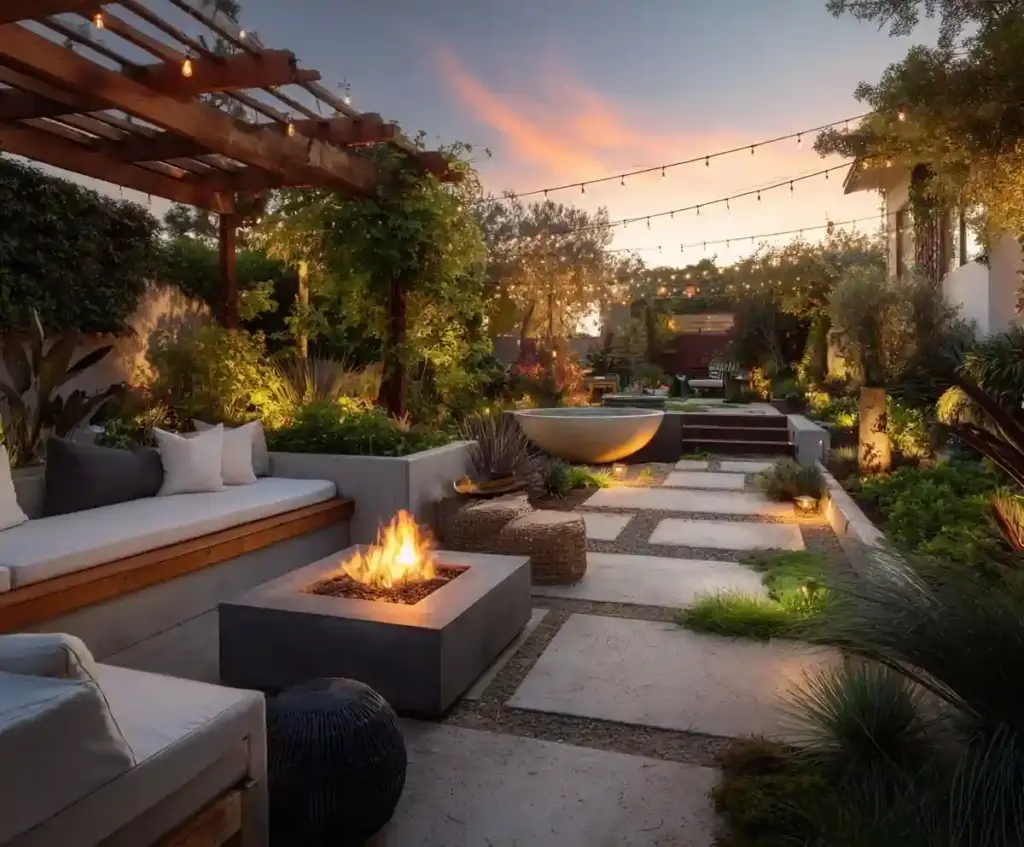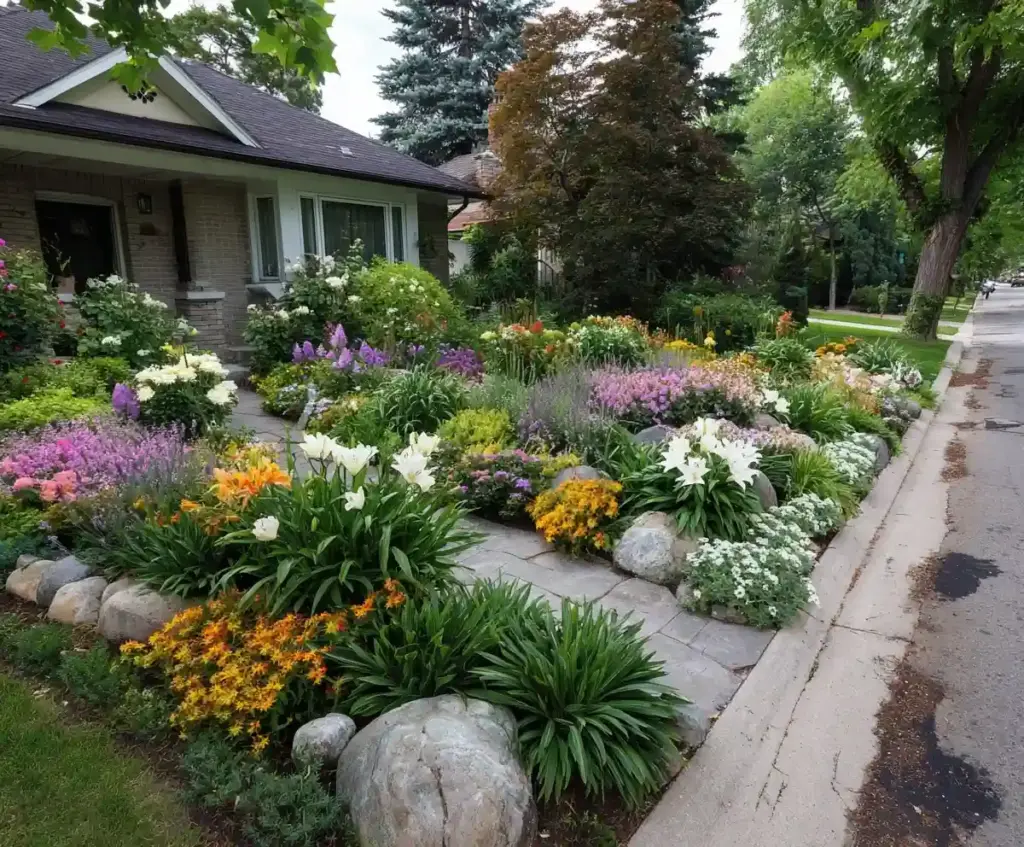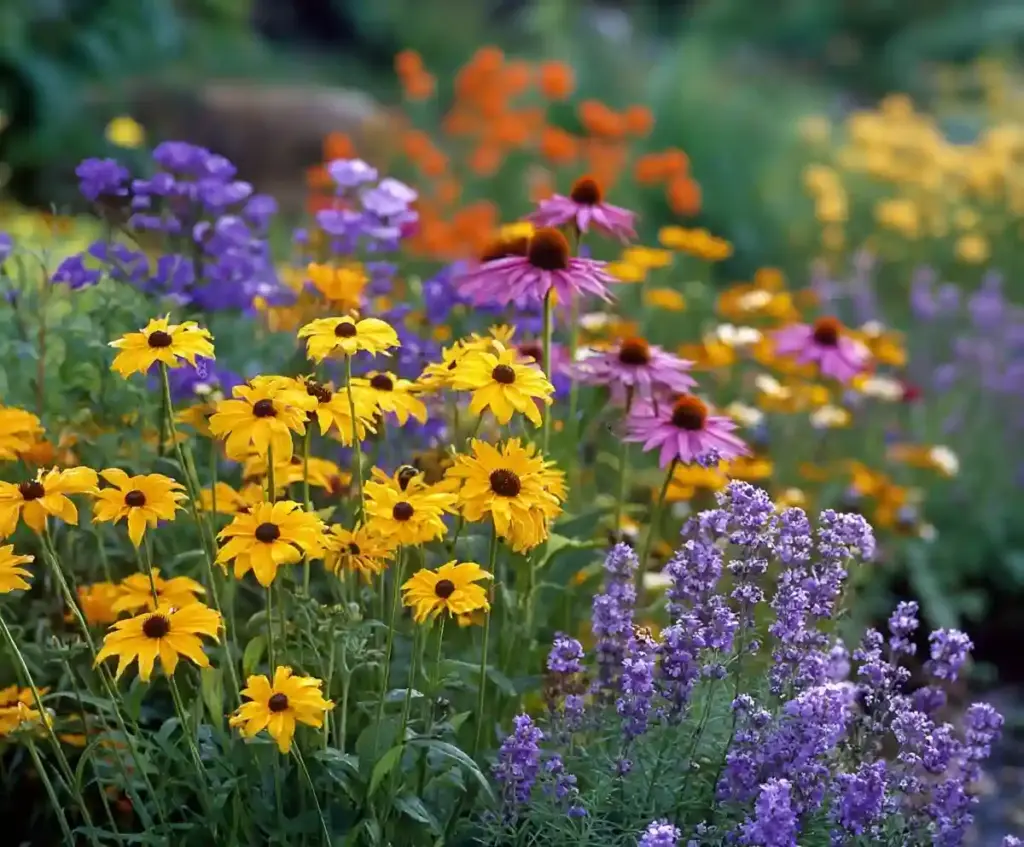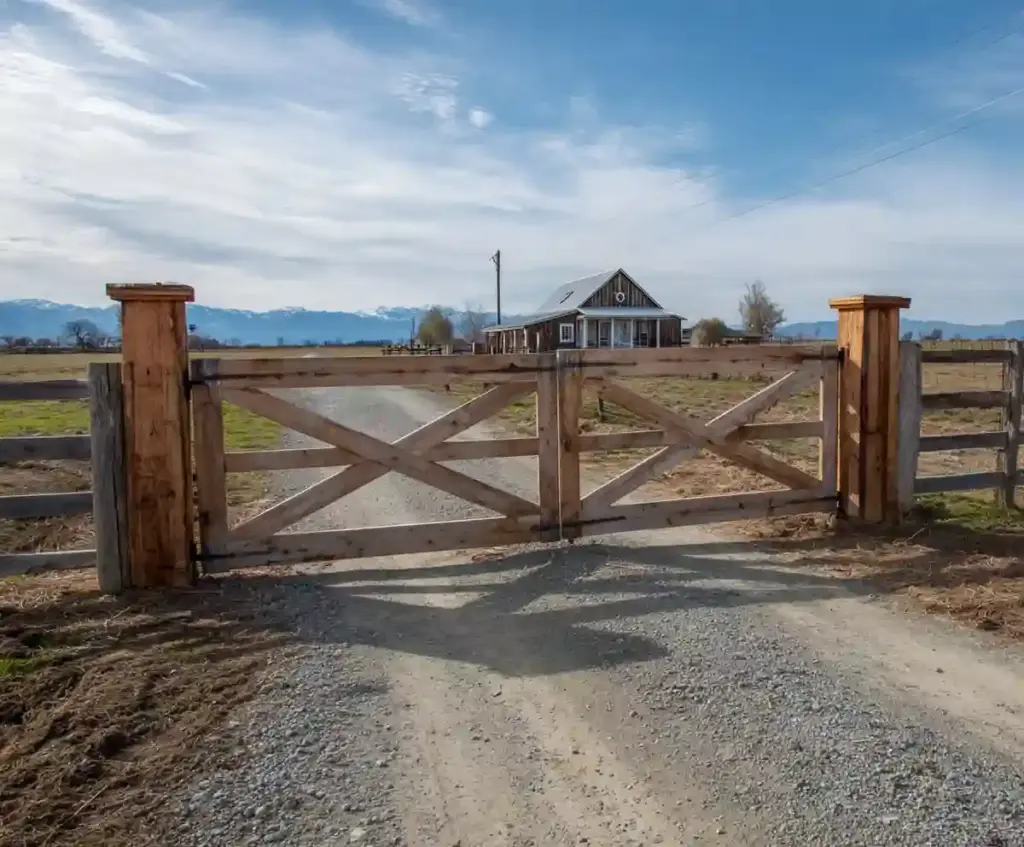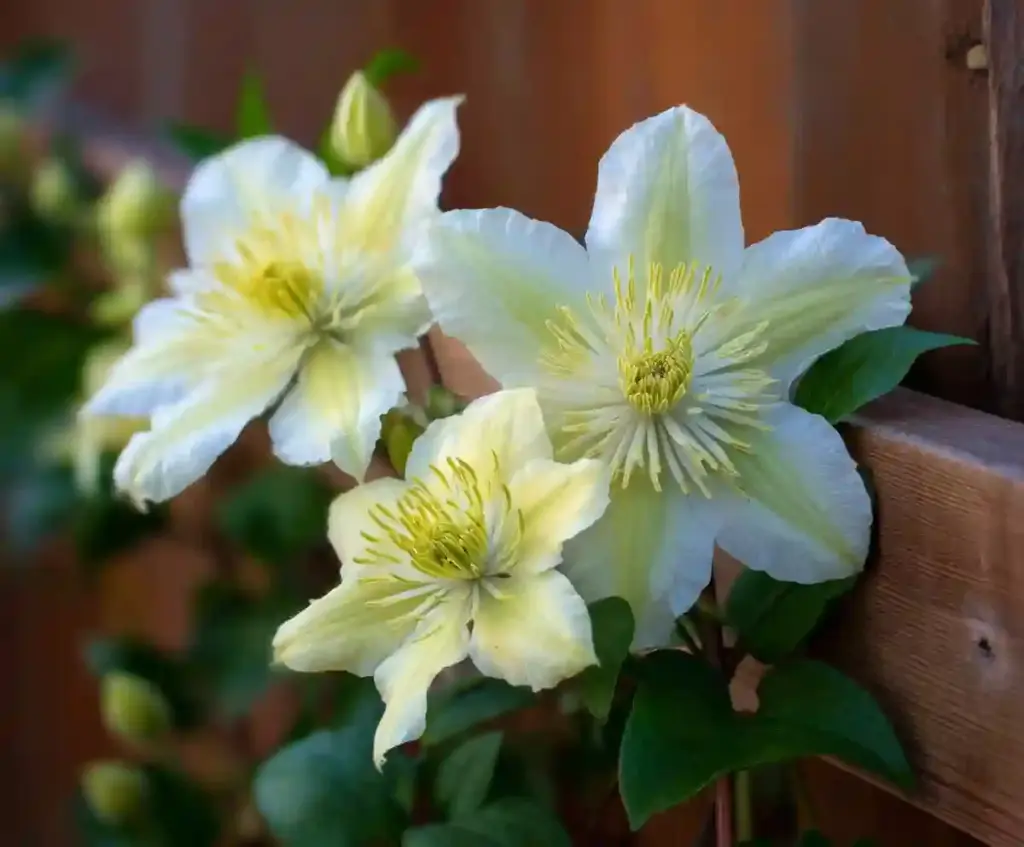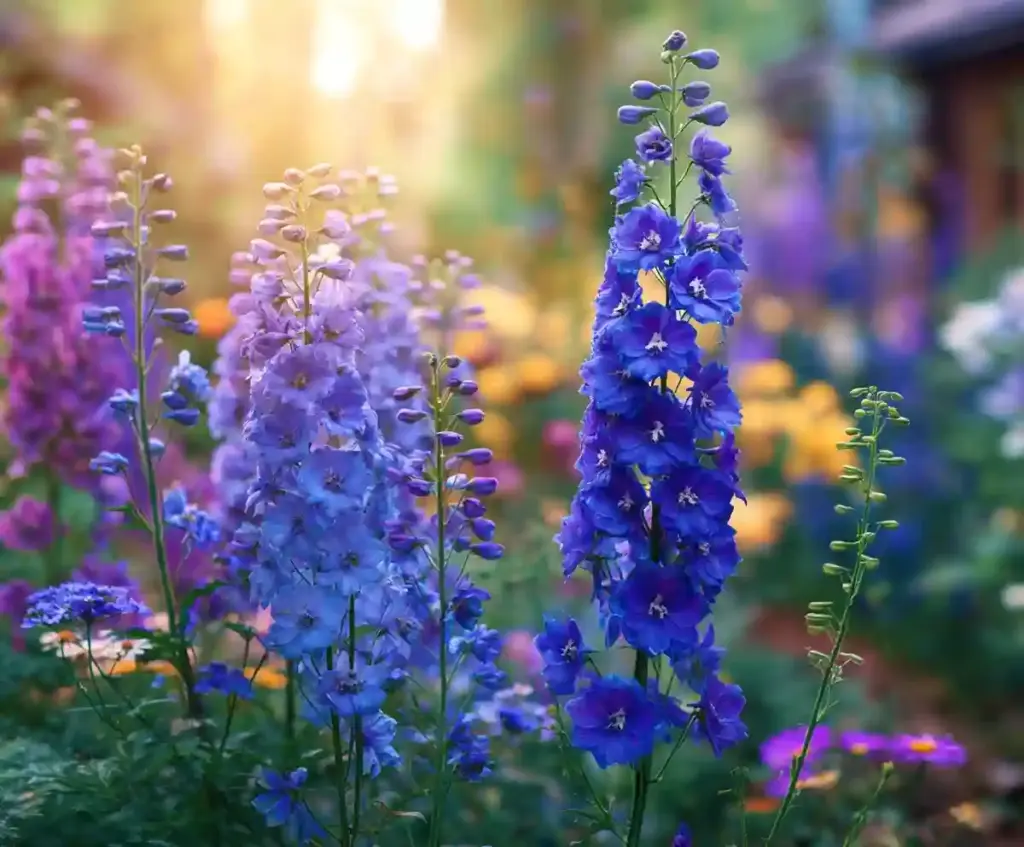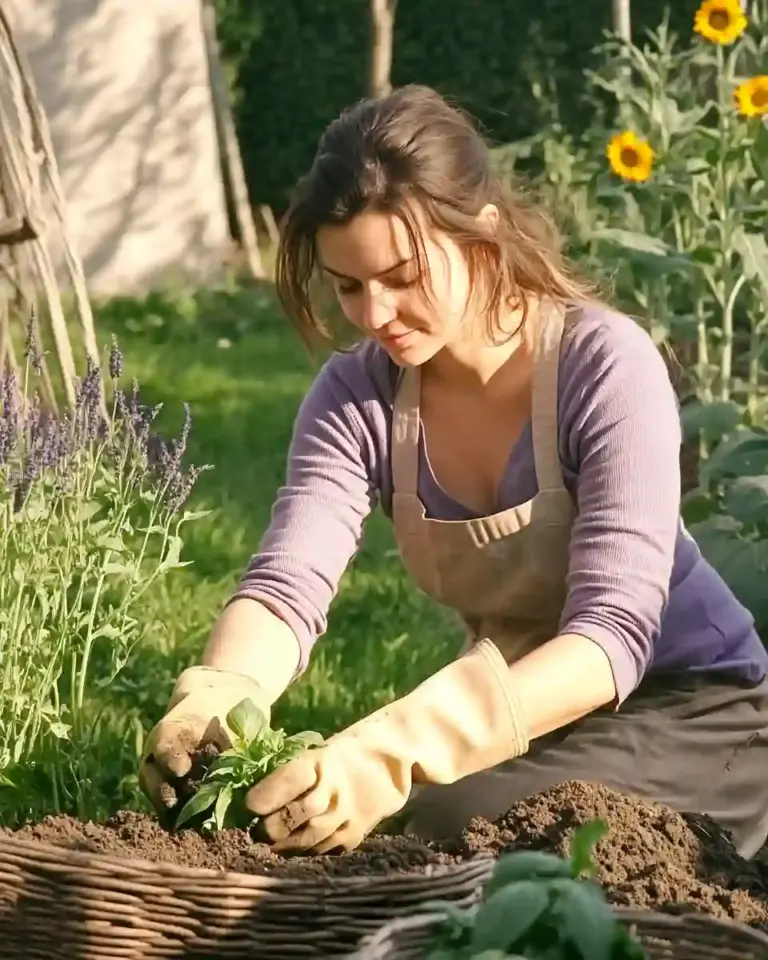Types of hibiscus flowers add vibrant color and tropical charm to gardens in any climate. From towering shrubs to compact container plants, these bold bloomers come in countless shapes, sizes, and colors.
Whether you need a privacy screen, a pollinator magnet, or a standout patio plant, there’s a hibiscus to match your space. In this guide, explore 44 stunning types of hibiscus flowers—perfect for every garden and growing zone.
Table of Contents
🌺 1. Swamp Hibiscus (Hibiscus coccineus)
Known for its striking red blooms and tall stature, swamp hibiscus is a showstopper in wet, sunny gardens. Native to the southeastern United States, it thrives in marshy soil, rain gardens, and along pond edges—places where many plants struggle to survive. The five-petaled flowers can span up to six inches across and bloom from mid-summer through early fall.
Swamp hibiscus can grow over 6 feet tall, making it an excellent choice for back borders or as a seasonal privacy screen. It prefers full to partial sun and needs consistent moisture to thrive, especially during its active growing season.
- Height: Over 6 feet
- USDA Zones: 6–9
- Flower Color: Vivid red
- Best for: Wet areas, pollinator gardens, tall accents
🌺 2. Cotton Rose (Hibiscus mutabilis)
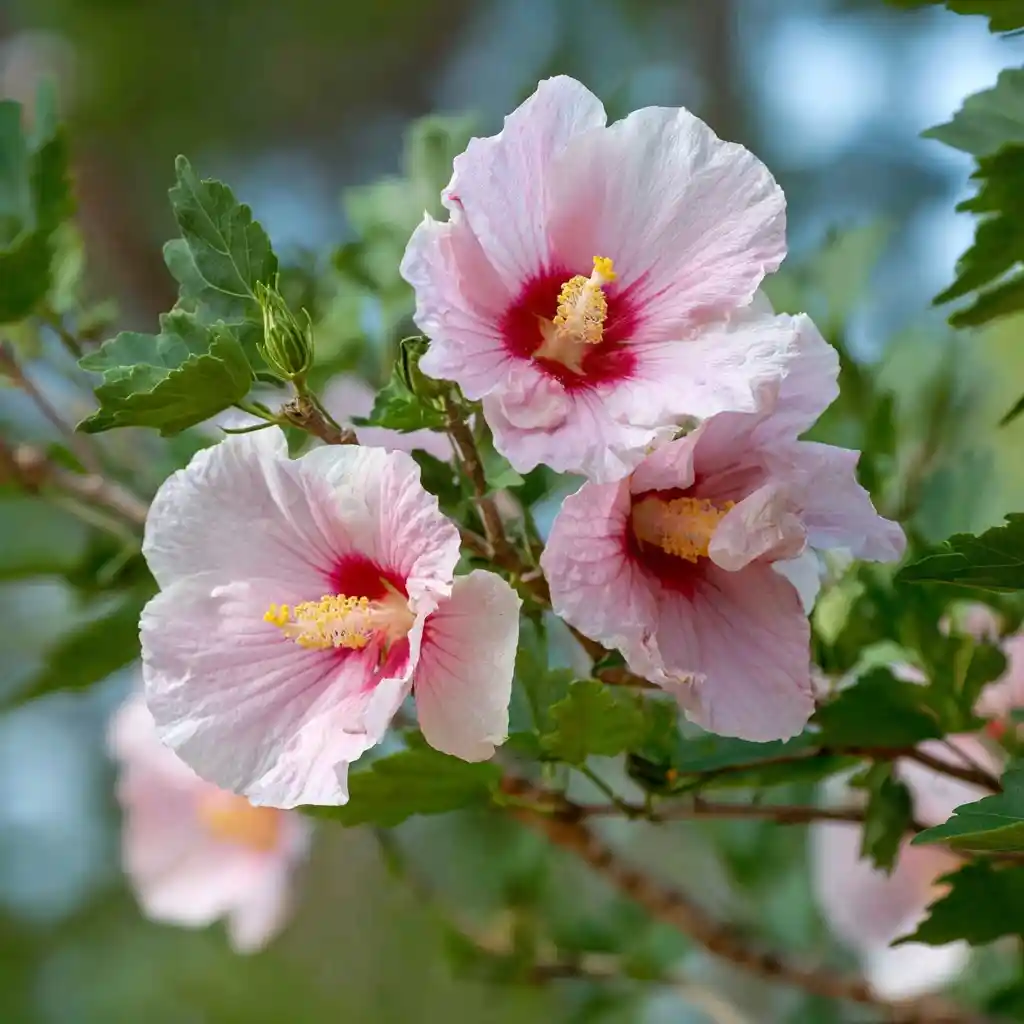
The cotton rose adds an unexpected twist to the hibiscus family. Its blooms change color as they mature—starting white in the morning, blushing pink by midday, and turning deep rose by evening. This fast-growing shrub resembles a small tree when fully mature, often reaching 15 feet tall.
Low-maintenance and deer-resistant, it’s a great choice for larger spaces where it can show off its seasonal drama. The fuzzy seed pods that follow flowering add late-season interest and help give the plant its name.
- Height: 6–15 feet
- USDA Zones: 7–11
- Flower Color: White, pink, red (color-changing)
- Best for: Cottage gardens, seasonal focal points
🌺 3. Rose of Sharon (Hibiscus syriacus)

A classic in temperate gardens, Rose of Sharon is a deciduous shrub that produces large, trumpet-shaped flowers from midsummer to fall. Unlike tropical types, it tolerates cooler weather and can thrive down to USDA Zone 5. Its upright, vase-shaped growth makes it ideal for hedges or as a specimen shrub.
This hibiscus flower variety often reseeds itself, which can be either a bonus or a chore, depending on your gardening goals. With minimal care and a reliable bloom cycle, it’s one of the easiest hibiscus types to grow.
- Height: 8–12 feet
- USDA Zones: 5–8
- Flower Color: Pink, purple, lavender, blue, red, white
- Best for: Borders, privacy screens, beginner gardeners
🌺 4. Rose of Sharon ‘Blue Chiffon’
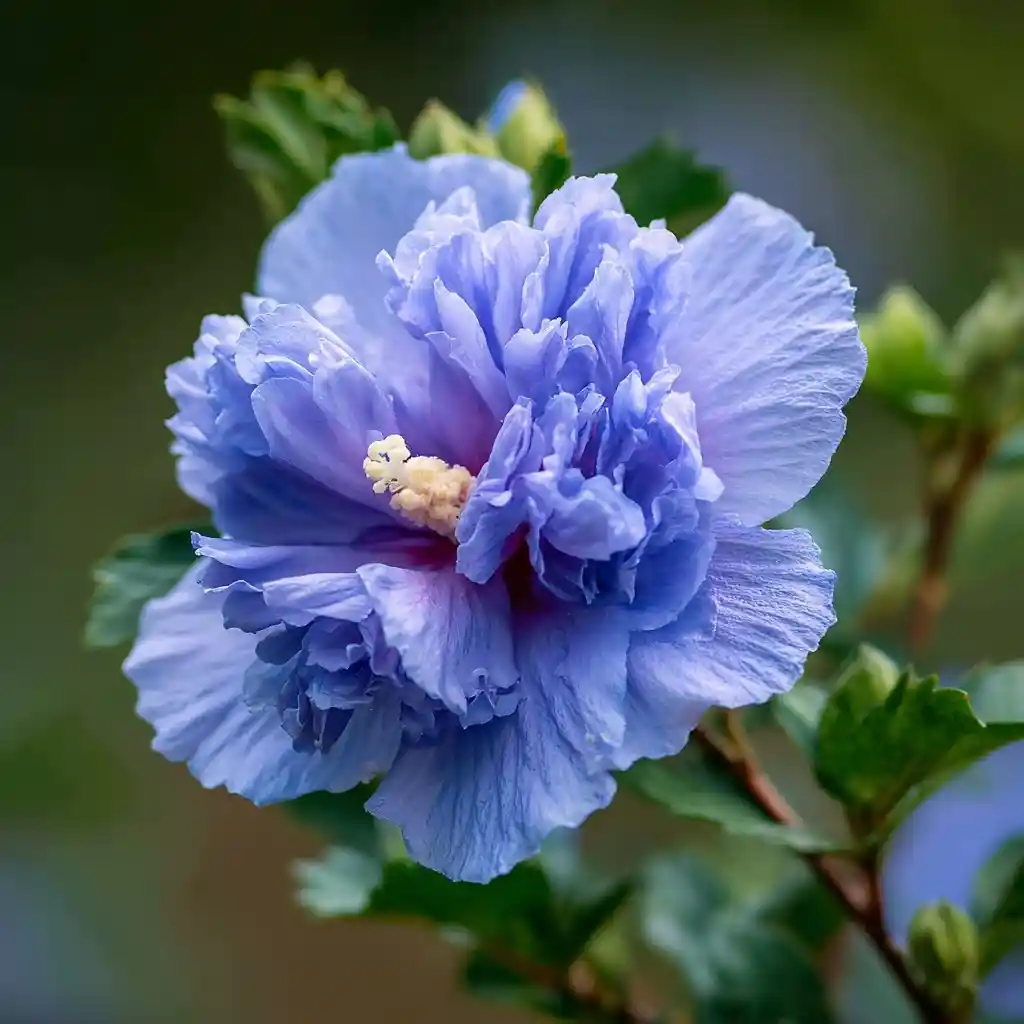
‘Blue Chiffon‘ is one of the most elegant types of hibiscus flowers, featuring delicate pale-blue petals with a soft ruffled texture. Unlike the solid blooms of standard Rose of Sharon, this variety adds a lacy, semi-double effect that catches the light and stands out in borders or foundation plantings.
It grows tall and upright, offering an airy look without sacrificing fullness. With blooms that last into fall and strong stems that resist flopping, it’s a favorite for adding graceful structure to sunny beds.
- Height: 8–12 feet
- USDA Zones: 5–9
- Flower Color: Pale blue
- Best for: Late-season interest, formal borders, foundation planting
🌺 5. Rose of Sharon ‘Sugar Tip’
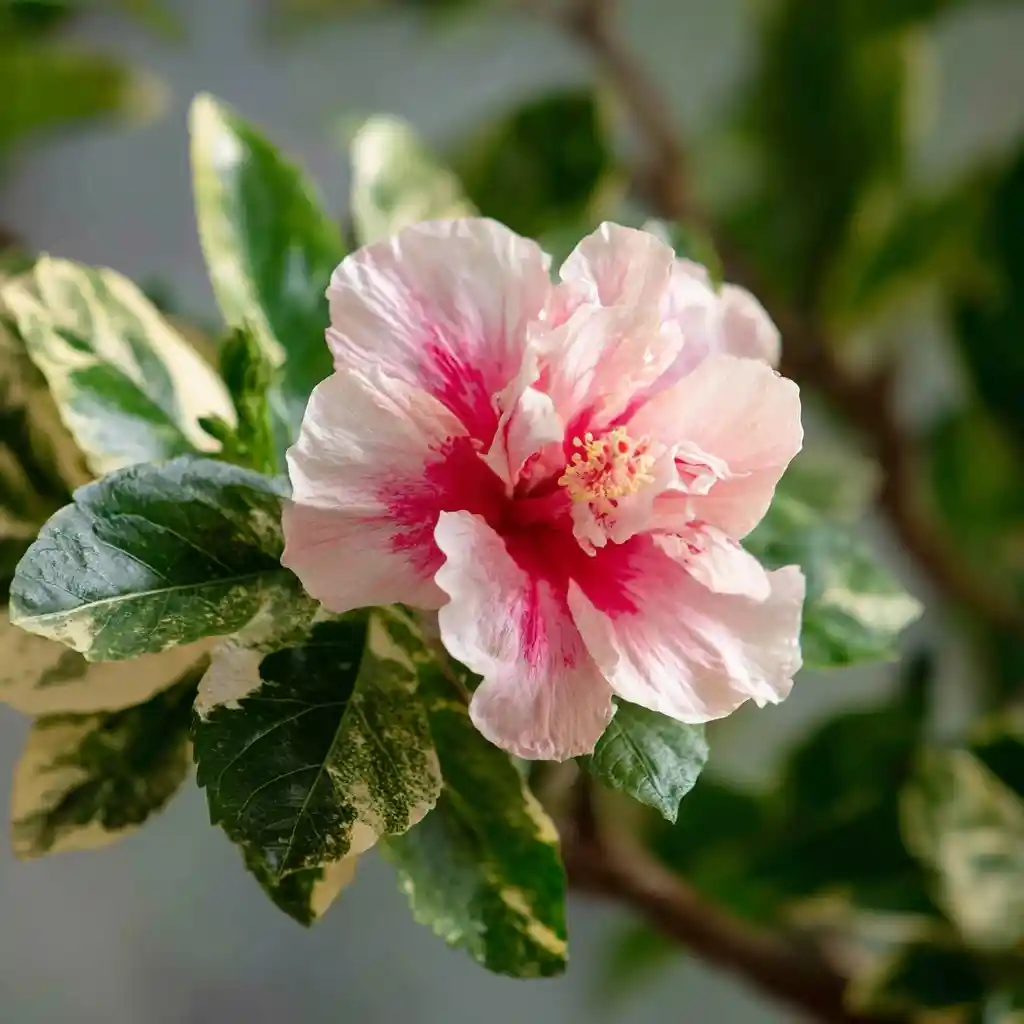
‘Sugar Tip’ combines candy-pink, double blooms with eye-catching variegated foliage—green leaves edged in creamy white. This seedless cultivar means less worry about unwanted spread, making it a tidy, low-maintenance option.
Its compact size makes it ideal for small gardens or containers. The hibiscus flower color is particularly vibrant against its foliage, offering multi-season visual appeal. It thrives in full sun and needs regular watering, especially in dry climates.
- Height: 5–6 feet
- USDA Zones: 5–8
- Flower Color: Pale pink with red centers
- Best for: Small spaces, containers, pollinator-friendly gardens
🌺 6. Rose of Sharon ‘Red Heart’
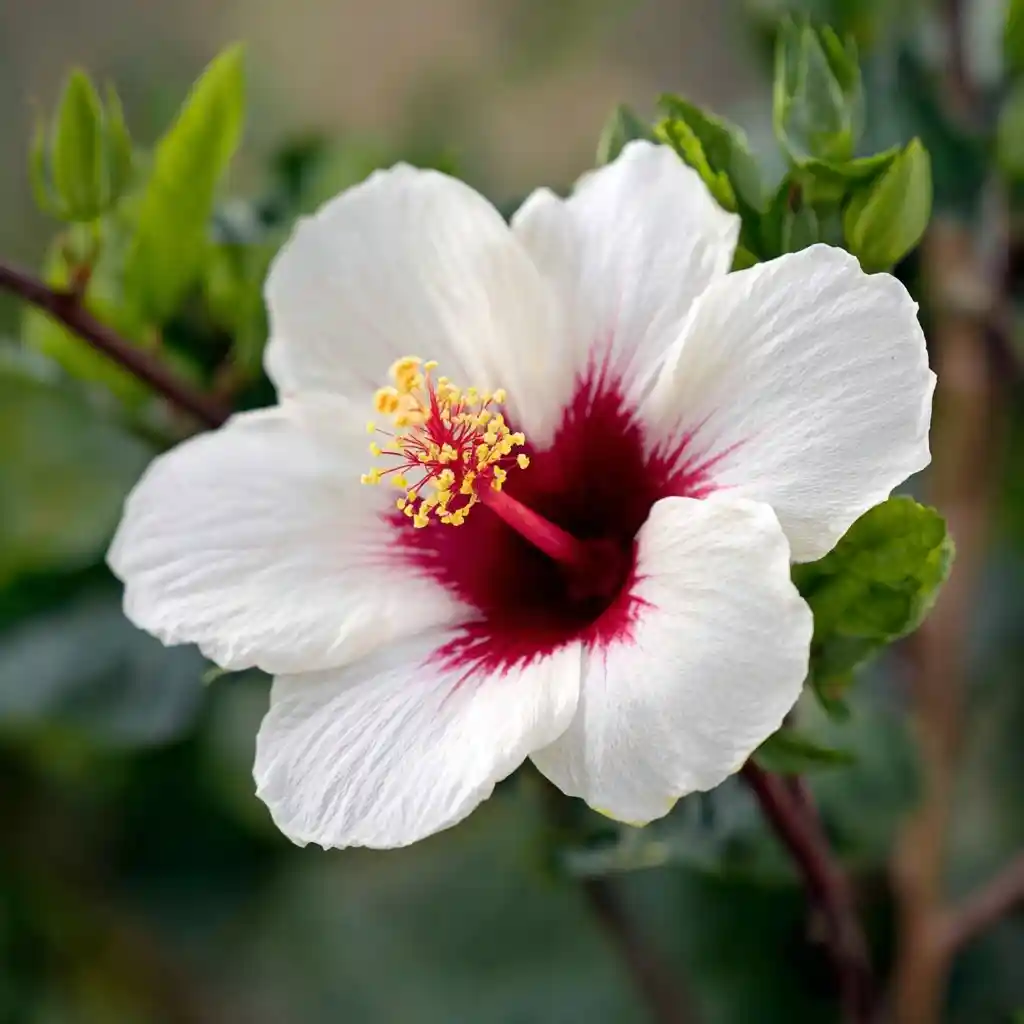
As its name suggests, ‘Red Heart’ blooms with pure white petals and a bold crimson center. Each flower lasts only a day, but the shrub produces them in abundance throughout the summer and into fall. The strong stems help it hold its shape well, making it ideal for hedging.
This cultivar grows well in full to partial sun and adapts to a range of soils, as long as they’re well-drained. Its striking contrast of white and red makes it a standout among hibiscus flower varieties.
- Height: 8–10 feet
- USDA Zones: 5–9
- Flower Color: White with red center
- Best for: Hedges, formal landscapes, bright focal points
🌺 7. Rose of Sharon ‘White Chiffon’
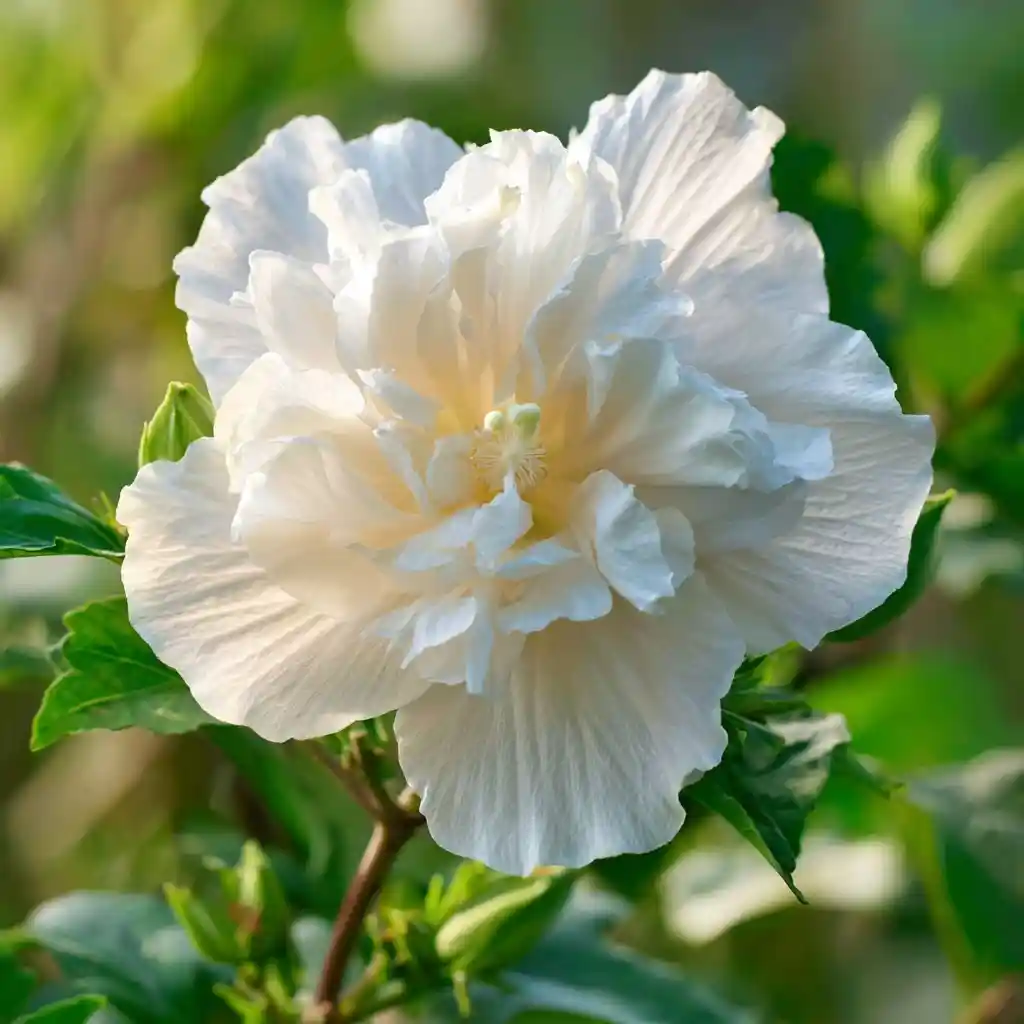
If you’re looking for a hibiscus flower that delivers elegance without flash, ‘White Chiffon‘ is a refined option. Its blooms are fully white, without the usual dark center common in many varieties. The semi-double flowers feature soft ruffled petals that add texture and depth, giving the shrub a delicate and graceful appearance.
This cultivar is highly tolerant of heat, drought, and salt, making it a great choice for more challenging growing conditions. It blooms steadily through the summer, providing long-lasting seasonal interest.
- Height: 8–12 feet
- USDA Zones: 5–9
- Flower Color: Pure white
- Best for: Coastal gardens, hot climates, clean color palettes
🌺 8. Rose of Sharon ‘Aphrodite’
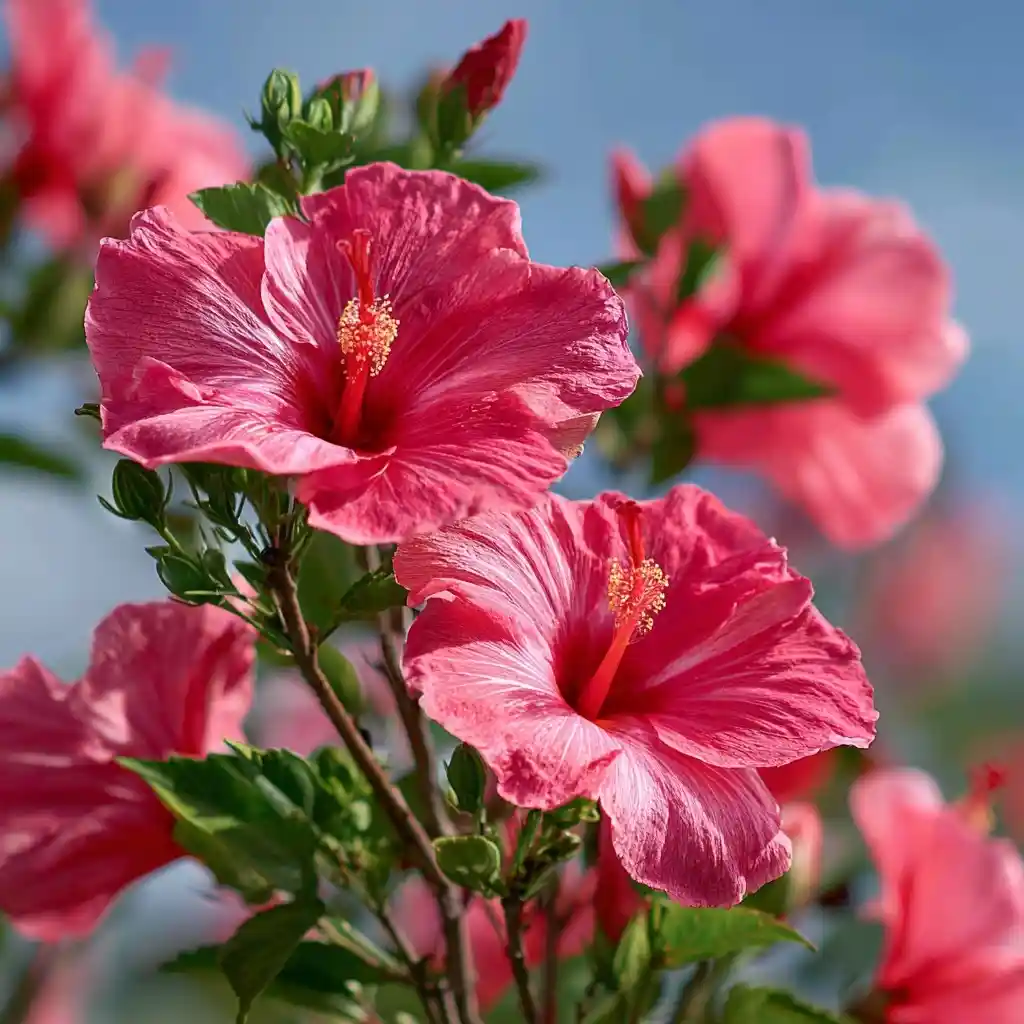
Compact and bushy, ‘Aphrodite‘ brings dramatic color with its large, pink hibiscus flowers and deep red centers. Its full shape means it works well as a standalone shrub or a flowering hedge. Another plus: it’s seedless, so you don’t have to worry about it spreading into unwanted areas.
This cultivar prefers full sun and responds well to light pruning, especially in early spring. With strong stems and dense foliage, it offers reliable performance in landscapes where consistent flowering is desired.
- Height: 6–10 feet
- USDA Zones: 5–8
- Flower Color: Bright pink with red throat
- Best for: Low-maintenance hedges, cottage gardens, butterfly attractor
🌺 9. Rose of Sharon ‘Blue Satin’
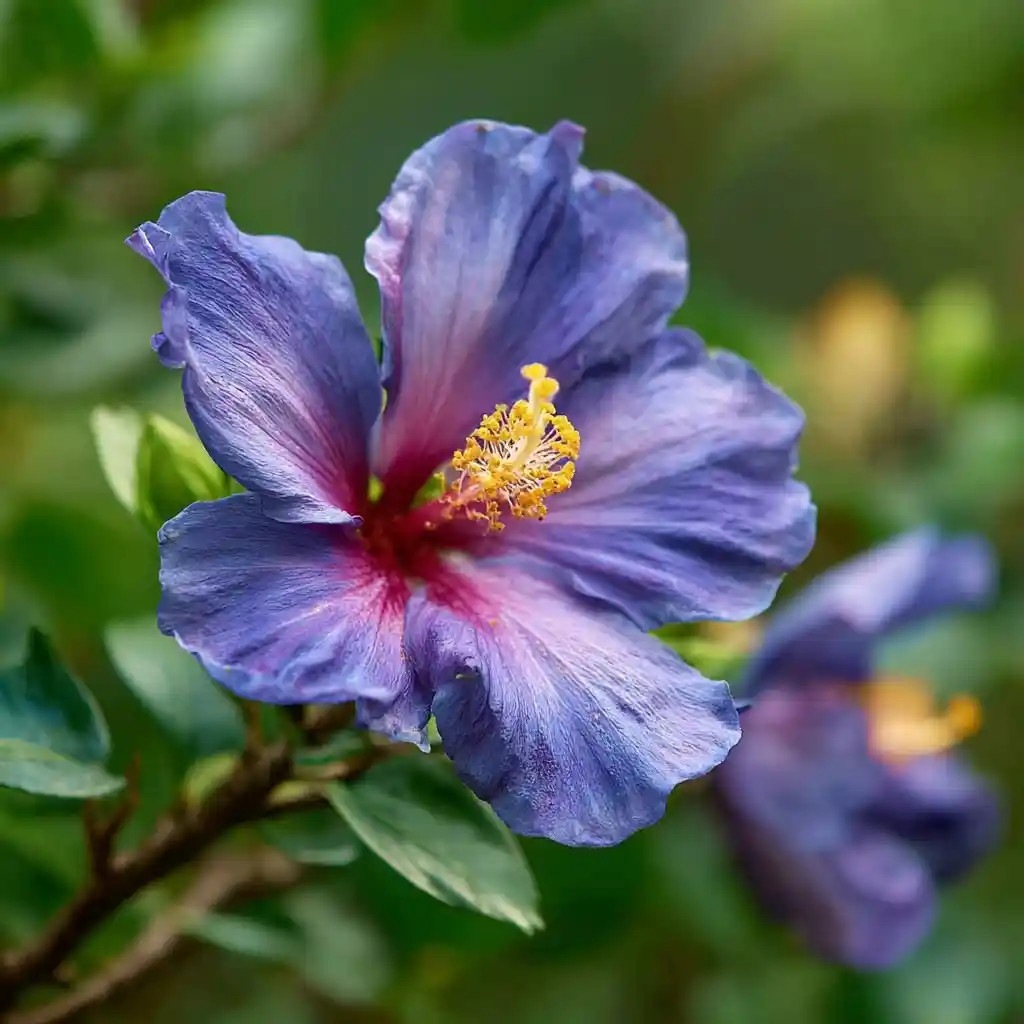
One of the most visually striking types of hibiscus flowers, ‘Blue Satin’ offers rich blue-violet blooms with ruby-red throats that stand out even from a distance. It’s heat-tolerant, drought-resistant, and salt-tolerant, making it a durable option in challenging landscapes.
This cultivar grows tall and upright with a full branching habit. The large blossoms make a dramatic impact and pair beautifully with warm-toned or white-flowering companions in the garden.
- Height: 8–12 feet
- USDA Zones: 5–9
- Flower Color: Blue-violet with red center
- Best for: Color contrast, sunny borders, resilient plantings
🌺 10. Rose of Sharon ‘Blueberry Smoothie’
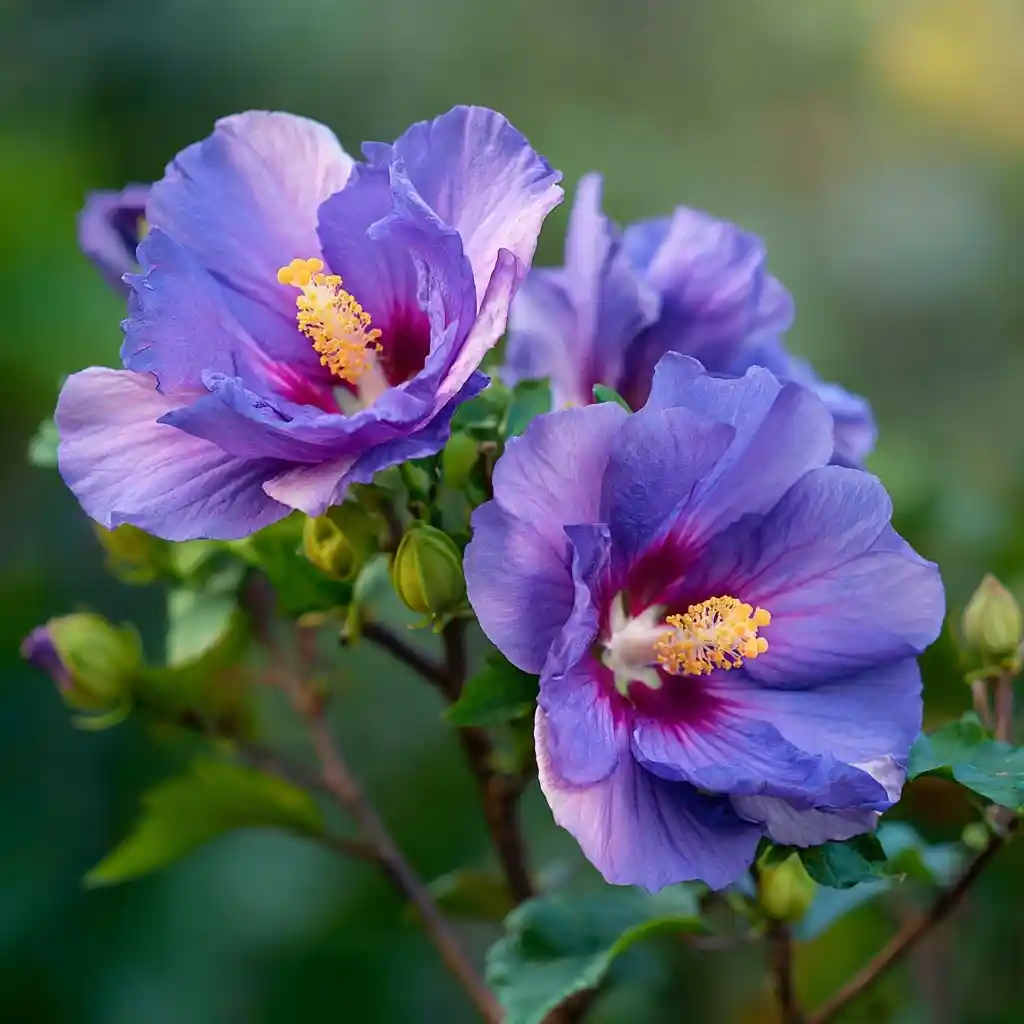
For gardeners who want blooms with extra flair, ‘Blueberry Smoothie‘ delivers. This double-flowered cultivar boasts layers of ruffled petals in vivid violet-blue hues that sometimes appear almost lavender or sky blue, depending on the light.
It’s a seedless variety, which means it stays where you plant it—no surprise seedlings popping up in unwanted places. Its upright growth habit and dramatic blooms make it perfect for containers or borders where its showy flowers can shine.
- Height: 8 feet
- USDA Zones: 5–8
- Flower Color: Violet-blue
- Best for: Statement shrubs, containers, floral focal points
🌺 11. Rose of Sharon ‘Lavender Chiffon’
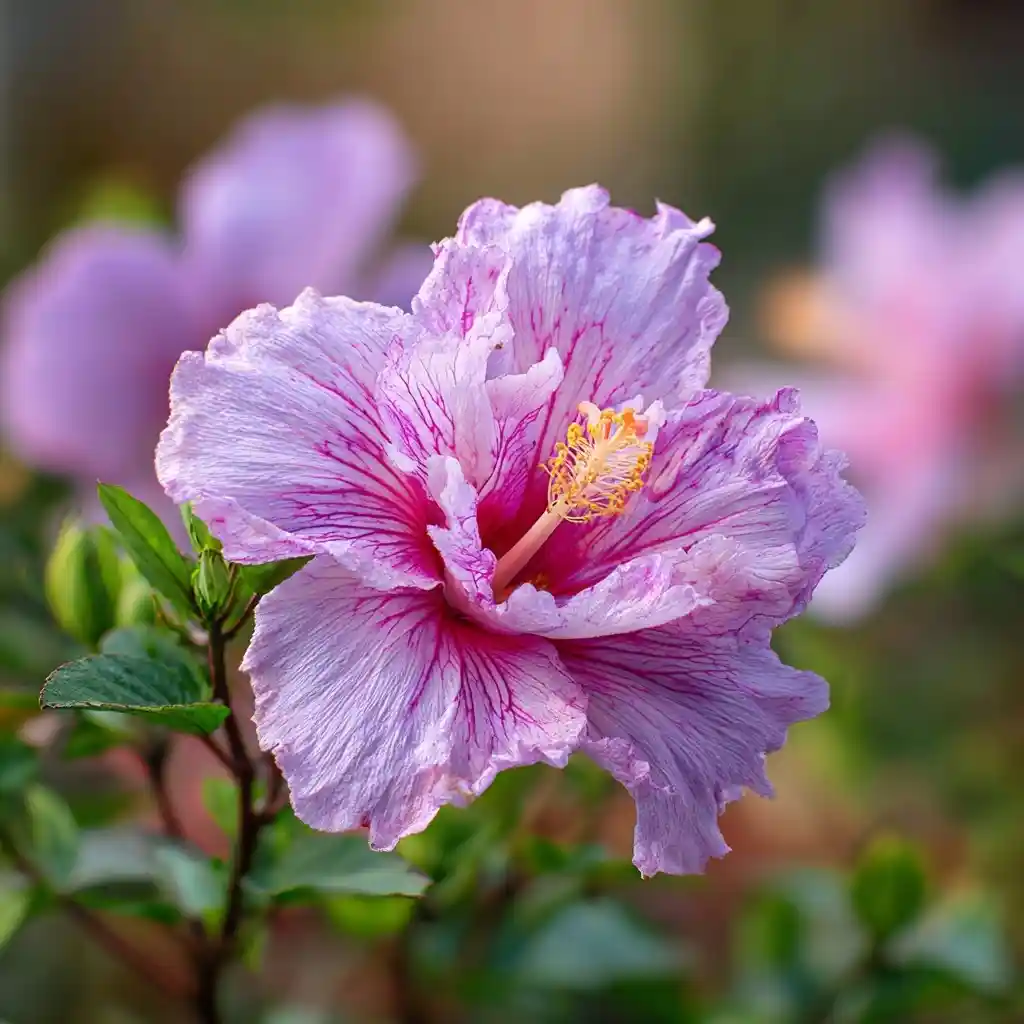
A soft and romantic hibiscus flower variety, ‘Lavender Chiffon‘ offers semi-double blooms in pastel lavender with faint red veining. It’s seedless and low-maintenance, ideal for gardeners who want beauty without the burden of frequent upkeep.
Its bushy habit makes it excellent for use as a privacy hedge or mass planting. It also grows well in large pots and responds nicely to pruning, which encourages even more blooms in late summer.
- Height: 8–12 feet
- USDA Zones: 5–9
- Flower Color: Lavender with red veins
- Best for: Privacy screens, soft garden palettes, container gardening
🌺 12. Rose of Sharon ‘Lil Kim’
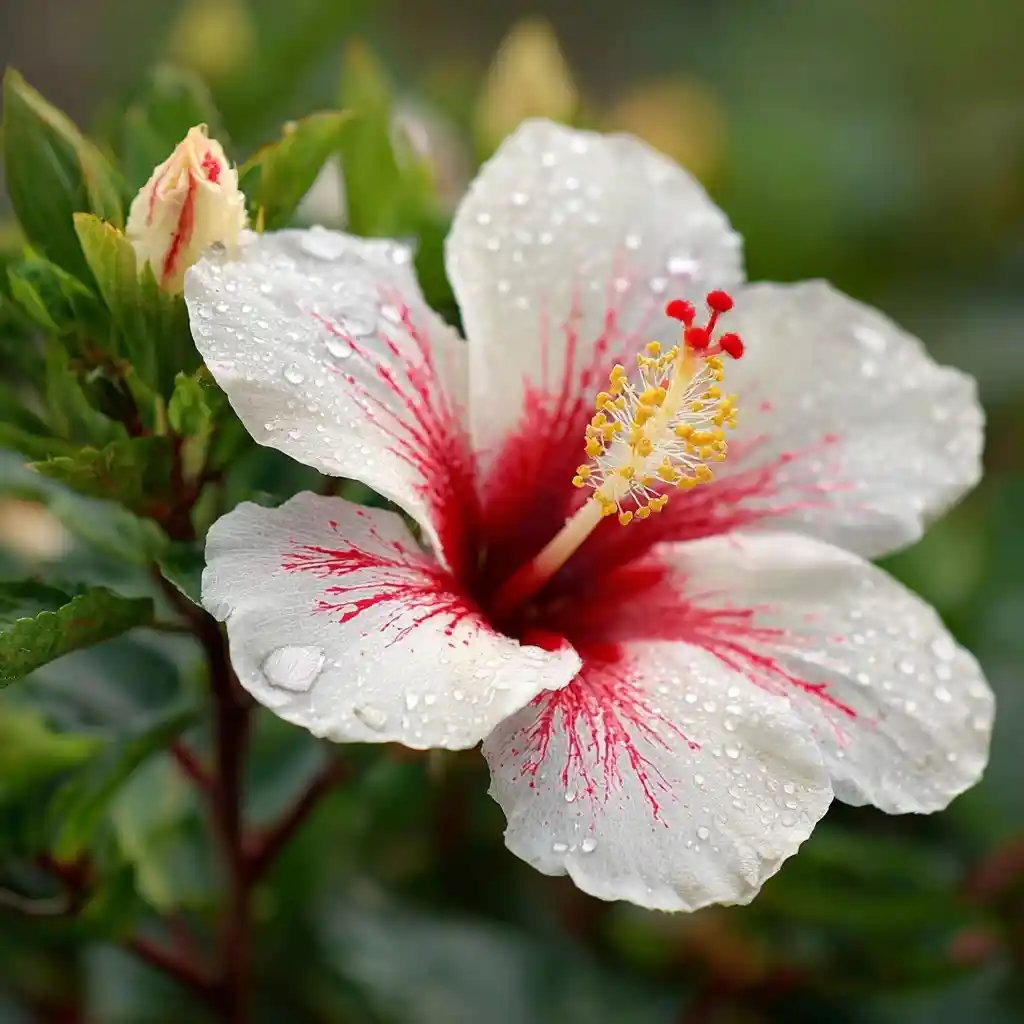
Short on space? ‘Lil Kim‘ is a dwarf hibiscus flower variety that grows just 3–4 feet tall, making it perfect for patios, small beds, or containers. It features large white flowers with striking red centers and bold veining.
Despite its small size, it delivers plenty of blooms through the summer months. Like other modern cultivars, it’s sterile—so there’s no unwanted reseeding. It’s an ideal pick for adding impact without taking up much room.
- Height: 3–4 feet
- USDA Zones: 5–9
- Flower Color: White with red center
- Best for: Small gardens, edging, container displays
🌺 13. Rose of Sharon ‘Lucy’
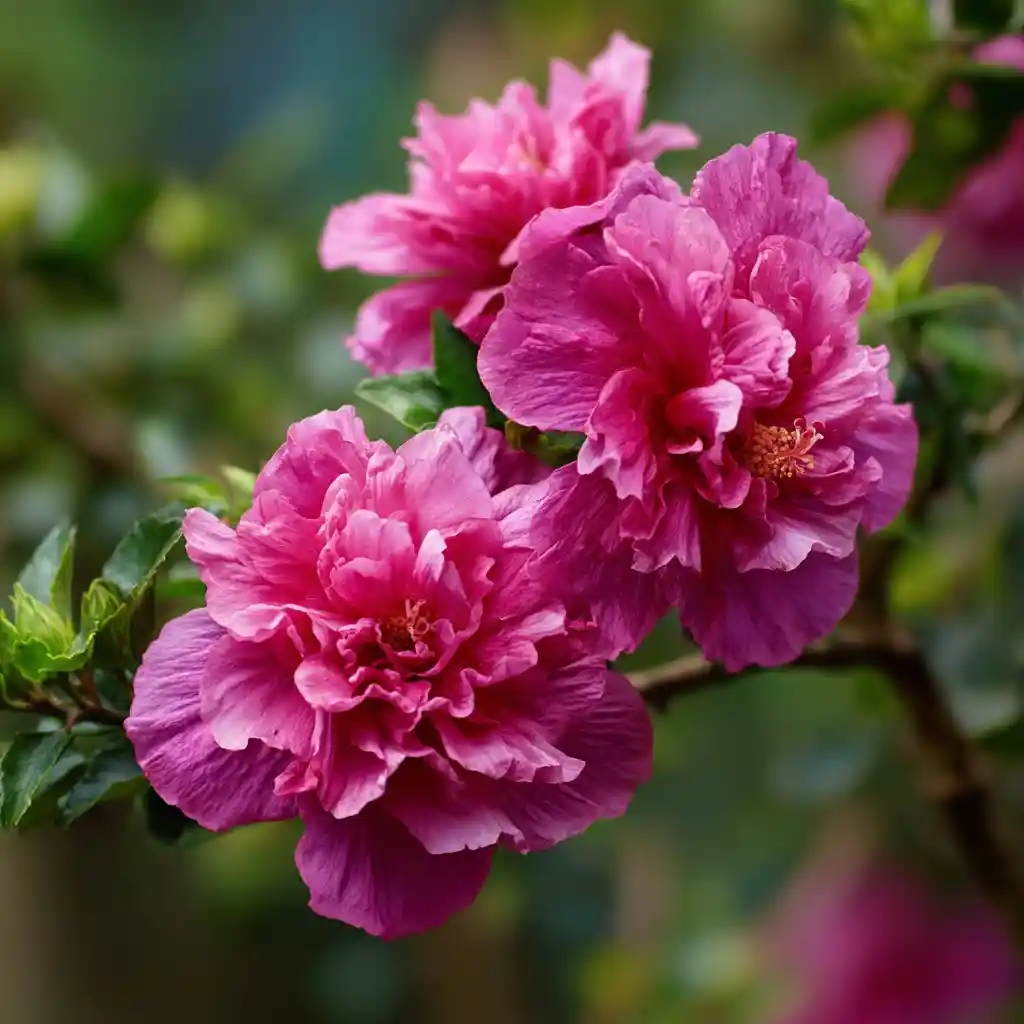
Bold and full of personality, ‘Lucy‘ is a double-flowered cultivar with ruffled, deep magenta blooms that stand out against its rich green foliage. The blooms are dense and luxurious, giving the shrub a lush, almost tropical look.
‘Lucy’ grows into a full, rounded shape, making it ideal for hedging or for shaping into a small flowering tree with pruning. It’s a sterile variety, so you won’t need to worry about spreading.
- Height: 6–8 feet
- USDA Zones: 5–8
- Flower Color: Reddish-fuchsia (magenta)
- Best for: Flowering hedges, statement shrubs, vibrant accents
🌺 14. Rose of Sharon ‘Minerva’

‘Minerva‘ features large, showy blooms in soft lavender-pink with a deep red center and ivory stamen, giving it a beautiful two-tone effect. This cultivar is both drought- and heat-tolerant, thriving even in less-than-perfect soil conditions.
Its upright shape and long flowering season make it an ideal choice for sunny garden beds or mixed borders. To promote fuller growth and more blooms, prune in early spring.
- Height: Up to 10 feet
- USDA Zones: 5–8
- Flower Color: Pinkish-purple with red center
- Best for: Hardy perennial gardens, mixed borders, low-care landscapes
🌺 15. Rose of Sharon ‘Purple Pillar’
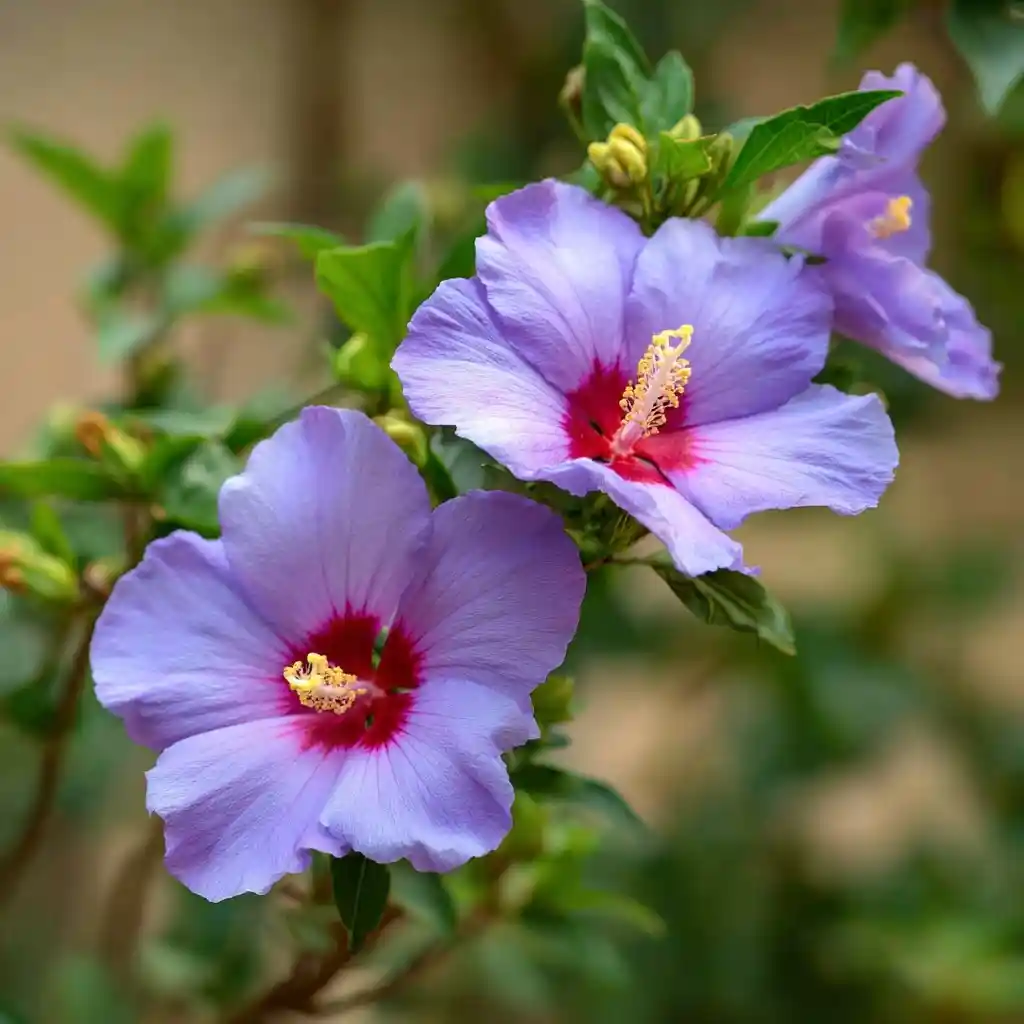
Unlike most spreading hibiscus flower varieties, ‘Purple Pillar‘ grows in a narrow, columnar shape—perfect for tight spaces or vertical interest. Despite its slim form, it produces loads of pale purple, double-petaled blooms with red throats throughout summer.
This compact footprint makes it an excellent option for urban gardens or areas with limited planting space. It works beautifully flanking doorways, driveways, or fences without overwhelming the area.
- Height: 10–16 feet
- USDA Zones: 5–9
- Flower Color: Pale purple with red center
- Best for: Narrow spaces, vertical accents, privacy screens
🌺 16. Rose of Sharon ‘Orchid Satin’
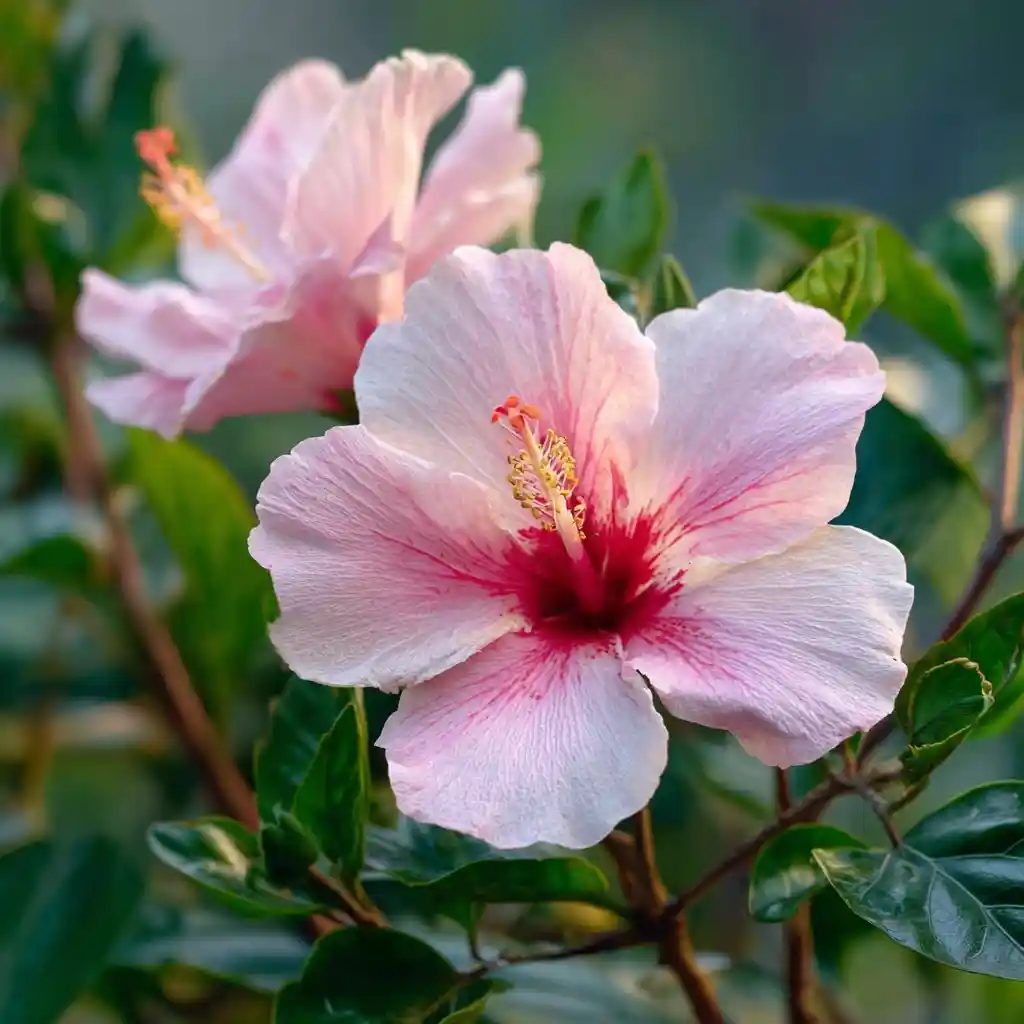
If you’re after types of hibiscus flowers with bold visibility, ‘Orchid Satin‘ delivers with its large, single blooms in pale orchid-pink and dramatic red throats. The petals feature fine veining that radiates from the center, adding depth and texture to each blossom.
This cultivar has a broad, upright growth habit, producing dense foliage that makes it excellent for privacy hedges or back-of-the-border plantings. It’s seedless and blooms heavily from mid-summer through fall.
- Height: 8–12 feet
- USDA Zones: 5–9
- Flower Color: Lavender-pink with red throat
- Best for: Flowering hedges, visual impact, late-season blooms
🌺 17. Rose of Sharon ‘Purple Satin’
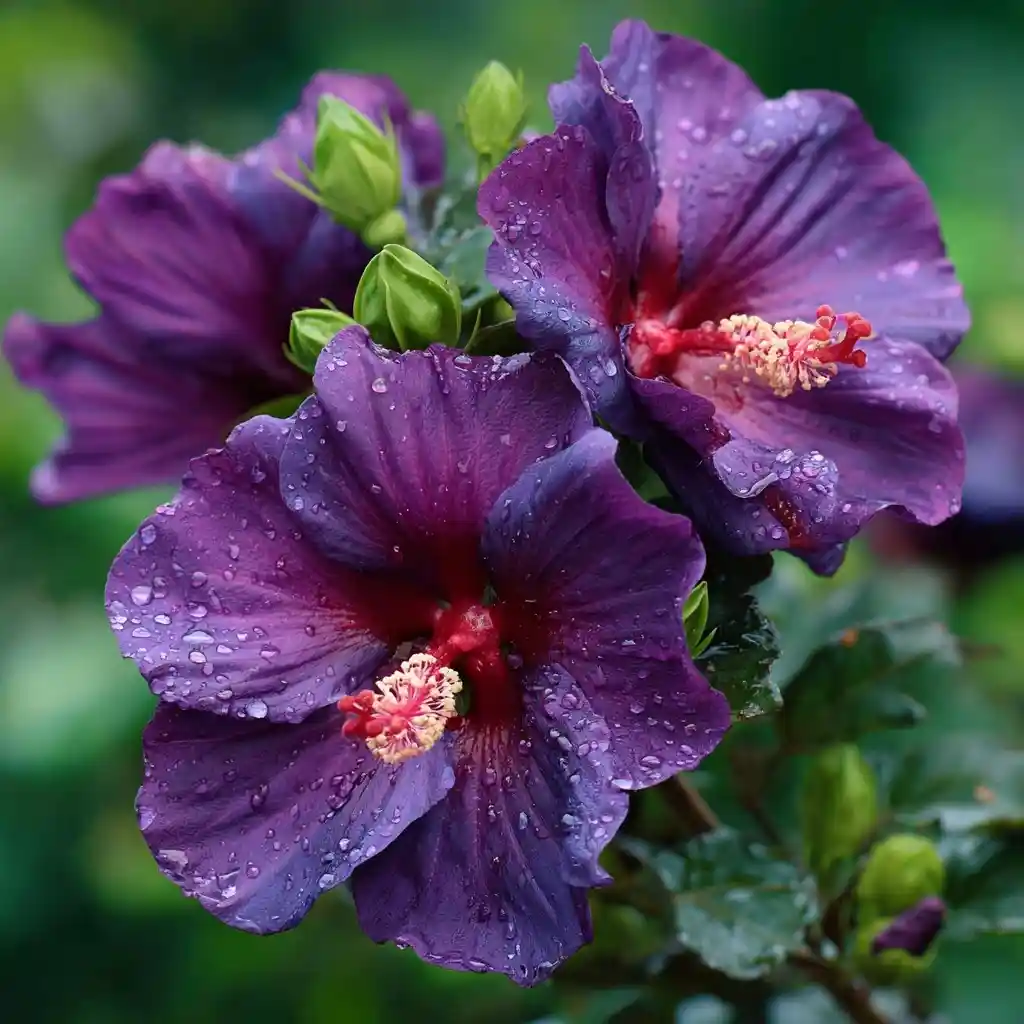
A heat- and drought-tolerant favorite, ‘Purple Satin‘ boasts deep purple blooms with dark red centers and bright yellow stamens. Its long-lasting flowers and robust structure make it a top pick for gardeners seeking a dramatic splash of color that holds up under summer stress.
It has a naturally rounded shape and grows nearly as wide as it does tall, making it ideal as a standalone specimen or large grouping. Like others in the Satin series, it doesn’t self-seed, offering easy maintenance.
- Height: 8–12 feet
- USDA Zones: 5–9
- Flower Color: Rich purple with red throat
- Best for: Hot climates, focal points, colorful screening
🌺 18. Rose of Sharon ‘Sugar Tip Gold’
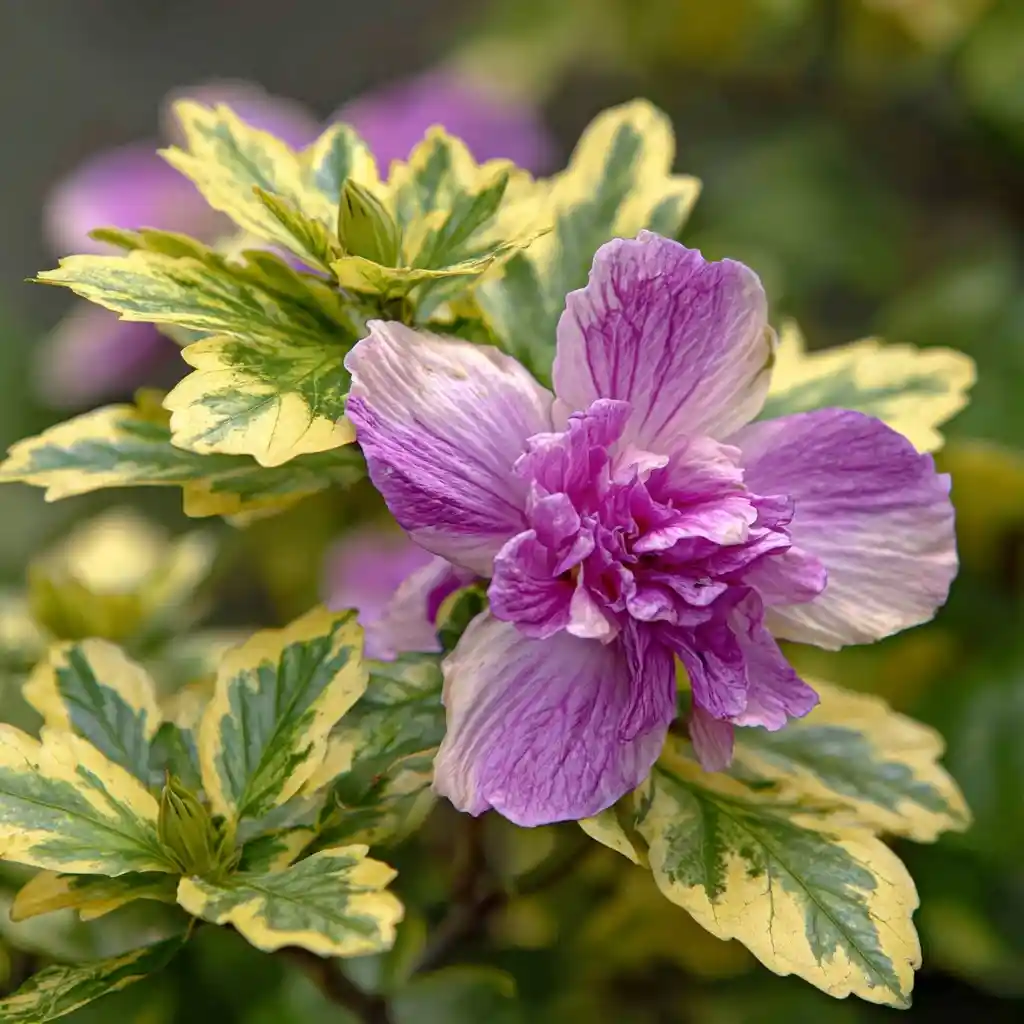
This colorful cultivar is unique not just for its double purple flowers but also for its golden-green variegated foliage. ‘Sugar Tip Gold‘ is compact and well-behaved, growing into a neat, bushy form without seeding itself into other areas.
Its multi-season interest—from spring foliage to late-summer flowers—makes it especially valuable in ornamental borders or containers. The leaf variegation gives it appeal even when not in bloom.
- Height: 4–5 feet
- USDA Zones: 5–9
- Flower Color: Purple
- Best for: Containers, foliage interest, small space gardening
🌺 19. Tropical Hibiscus
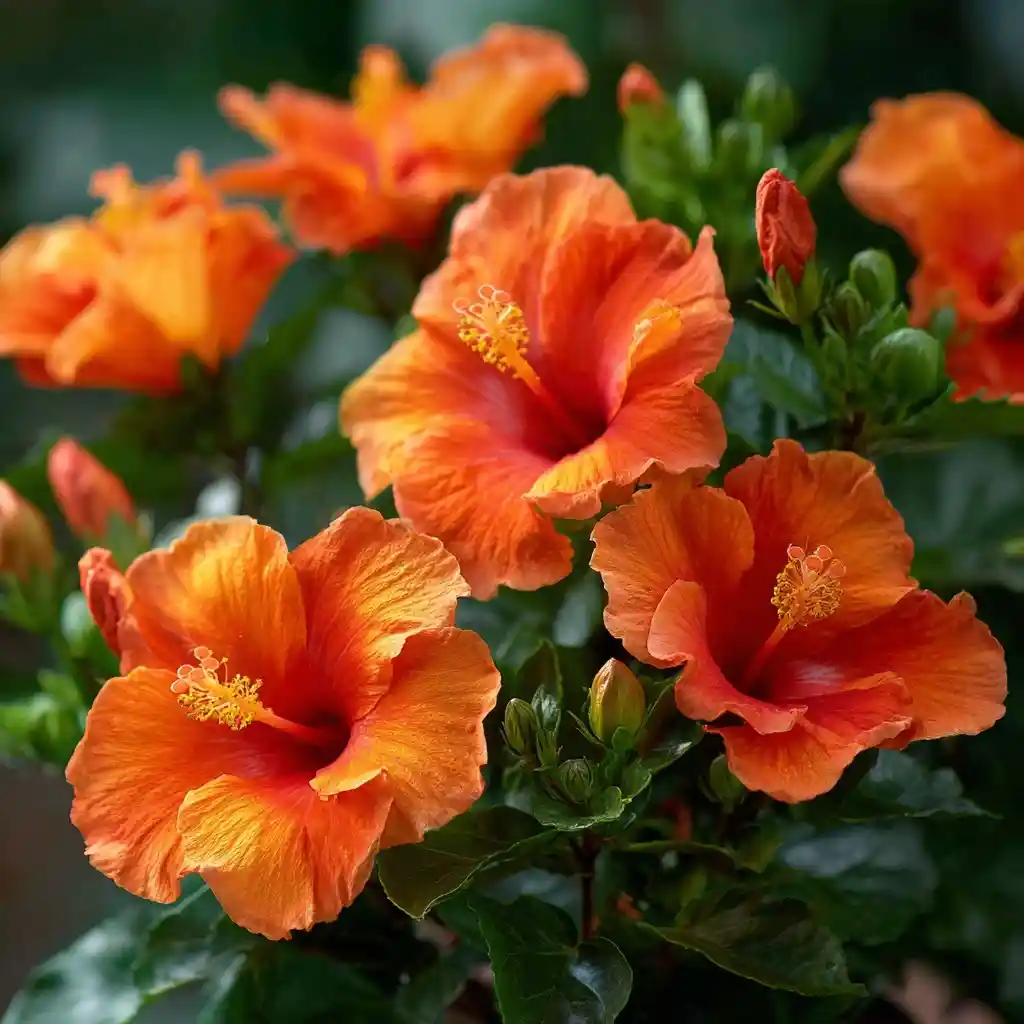
The tropical hibiscus is perhaps the most iconic of all types of hibiscus flowers, known for its large, trumpet-shaped blooms in fiery shades of red, orange, yellow, and pink. Native to warm climates, it thrives as a perennial in USDA Zones 9–12 or as a container plant in cooler areas.
This variety demands heat, humidity, and consistently moist soil. With the right care, it will bloom continuously throughout the growing season. Regular deadheading and feeding with a bloom-boosting fertilizer will keep the color coming.
- Height: 4–10 feet
- USDA Zones: 9–12
- Flower Color: Red, orange, pink, yellow, white
- Best for: Warm climates, patios, tropical-themed gardens
🌺 20. Hardy Hibiscus
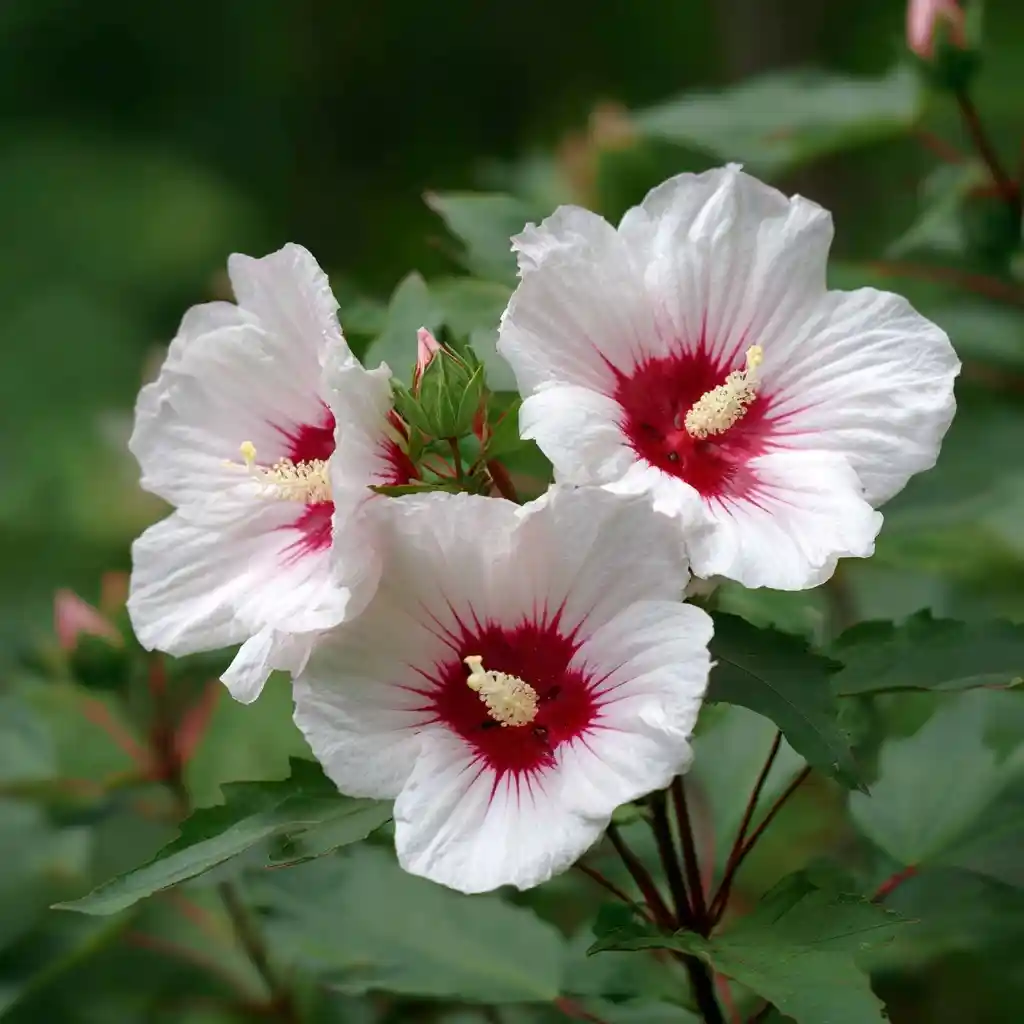
Don’t let the delicate appearance fool you—hardy hibiscus is built for cooler climates. This North American native produces massive, dinner-plate-sized blooms in white, pink, red, or blue, often with a dark central eye. It dies back to the ground in winter but returns each spring stronger than before.
Hardy hibiscus thrives in rich, moist soil and full sun. It makes a dramatic statement in perennial borders, especially when planted in groups.
- Height: 3–7 feet
- USDA Zones: 4–9
- Flower Color: White, pink, red, blue
- Best for: Northern gardens, rain gardens, bold color displays
🌺 21. Roselle

Known as Florida cranberry, roselle is prized not only for its ornamental pink flowers but also for its edible red calyces, which are used in herbal teas like hibiscus or “agua de jamaica.” The plant itself grows as a bushy shrub and needs long, warm seasons to reach maturity.
It performs best in well-drained soil and full sun, with regular watering. While it’s grown for culinary use, the flowers are just as stunning and can make an eye-catching addition to edible landscapes.
- Height: Up to 7 feet
- USDA Zones: 9–10
- Flower Color: Pale pink with red center
- Best for: Edible gardens, tea enthusiasts, tropical borders
🌺 22. Sea Hibiscus

Also known as mahoe, the sea hibiscus is a tropical tree that flourishes in coastal regions. Its lemon-yellow flowers with deep red centers open in the morning and fade to orange or red by day’s end, creating a beautiful, shifting color show.
This salt-tolerant species is ideal for seaside planting and is often used for erosion control due to its strong roots. Note: in certain regions like southern Florida, it can become invasive, so plant responsibly.
- Height: 12–25 feet
- USDA Zones: 10–12
- Flower Color: Yellow to red (color shifts)
- Best for: Coastal gardens, erosion control, tropical windbreaks
🌺 23. Cranberry Hibiscus
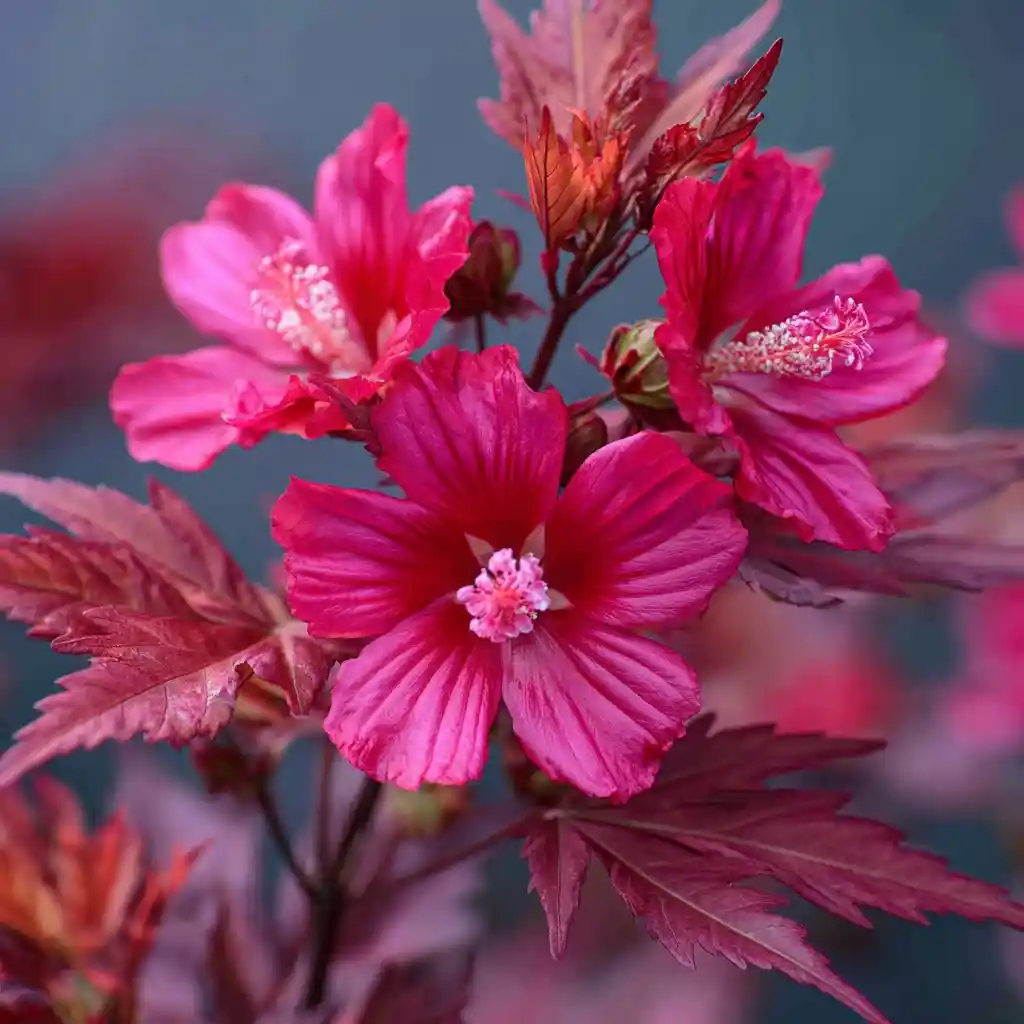
Loved more for its foliage than its flowers, cranberry hibiscus features deeply lobed, burgundy-red leaves that resemble Japanese maple. The plant produces occasional small red or pink blooms, but its leaf color steals the spotlight.
It’s both ornamental and edible—young leaves have a tangy, citrus flavor and can be used in salads. Grow it as an annual in cooler zones or as a perennial in frost-free areas.
- Height: 3–6 feet
- USDA Zones: 9a–11b
- Flower Color: Red or pink
- Best for: Edible landscapes, foliage contrast, bold color accents
🌺 24. Coral Hibiscus
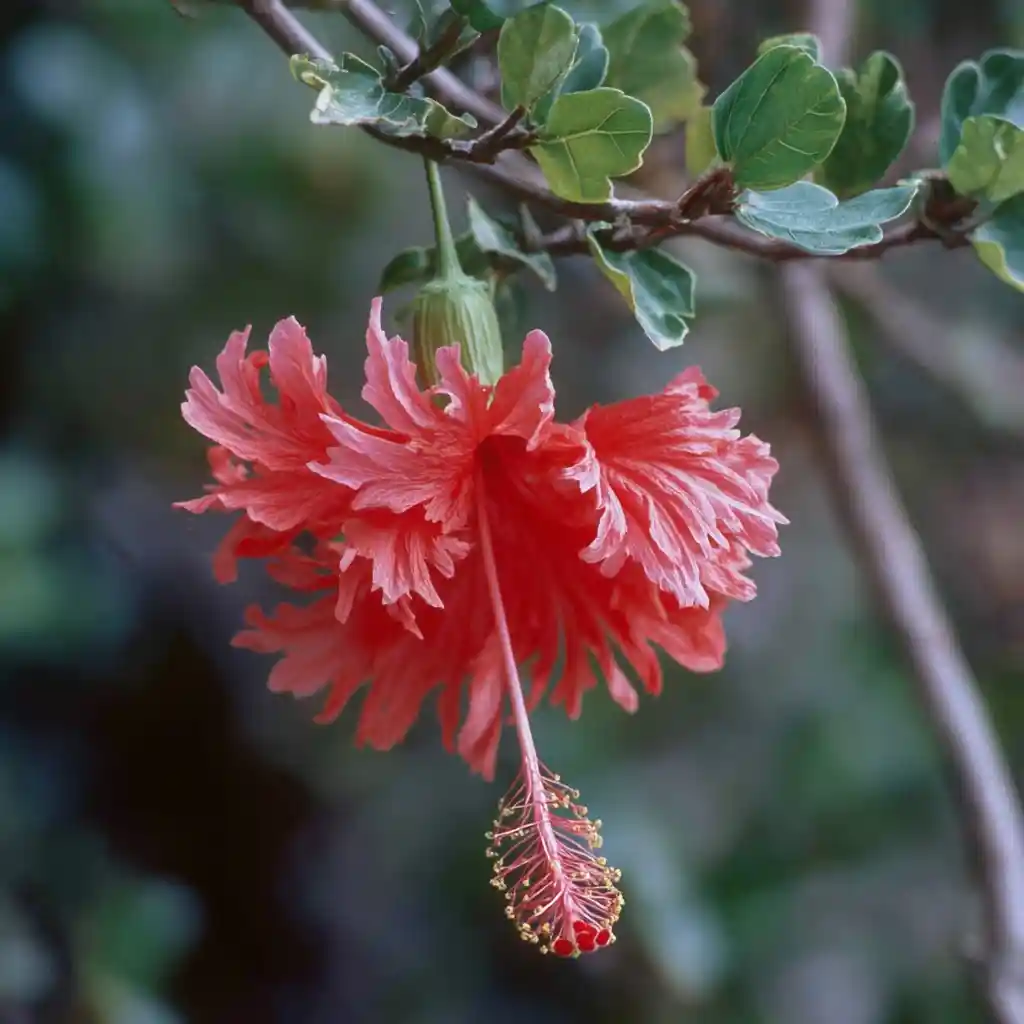
Also called fringed hibiscus or Japanese lantern, coral hibiscus has uniquely pendant flowers with lacy, deeply cut red petals and long, dangling stamens. It grows as a tropical shrub or small tree, and the blooms appear suspended, giving it a whimsical, exotic feel.
Because of its tropical nature, it does best in frost-free zones or in containers that can be moved indoors during winter. Coral hibiscus thrives in rich, moist soil and needs consistent humidity to flower well.
- Height: 10–12 feet
- USDA Zones: 10–12
- Flower Color: Coral red
- Best for: Tropical gardens, exotic plant collections, containers in humid climates
🌺 25. Swamp Rose-Mallow

The swamp rose-mallow is a North American native prized for its enormous, showy pink or white blooms with a soft, velvety texture. It’s perfectly adapted to wet environments and can tolerate standing water—making it an excellent choice for rain gardens or low-lying, poorly draining spots.
With as many as 20 flowers in bloom at once, this hardy perennial puts on a spectacular midsummer show. Give it plenty of sun and consistently moist soil to thrive.
- Height: 3–6 feet
- USDA Zones: 5–9
- Flower Color: Pink, white, or red
- Best for: Wetlands, rain gardens, naturalistic plantings
🌺 26. Hamabo Hibiscus

Hamabo hibiscus, native to East Asia, stands out for its cheerful, yellow blooms that fade into soft orange as they age. Flowers attract butterflies and hummingbirds, adding pollinator value to their visual appeal.
It’s a medium-sized shrub with an open, spreading form. Tolerant of salt and heat, it makes a great choice for subtropical and coastal landscapes. It does best with consistent moisture and can be pruned to control shape.
- Height: 6–15 feet
- USDA Zones: 8–12
- Flower Color: Yellow, fading to orange
- Best for: Pollinator gardens, coastal areas, informal hedges
🌺 27. Halberd-Leaf Rosemallow
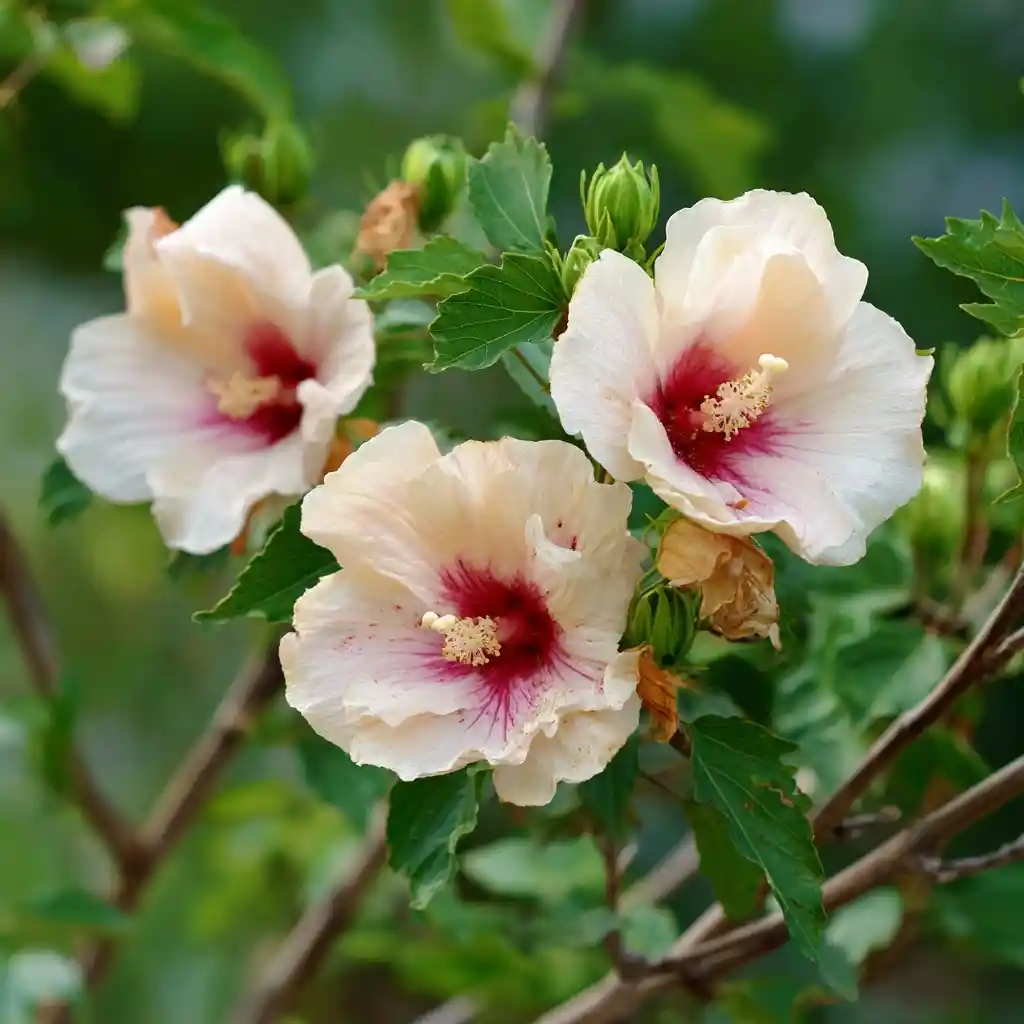
The halberd-leaf rosemallow earns its name from the shape of its foliage, which resembles a medieval halberd blade. Its delicate, cup-shaped flowers bloom in shades of white or pink, each with a contrasting red center.
This fast-growing native thrives in wet conditions like marshes and along streambanks. It’s an excellent plant for wildlife-friendly gardens, attracting bees, butterflies, and birds while stabilizing soggy soil.
- Height: Up to 6 feet
- USDA Zones: 4–9
- Flower Color: Creamy white, pink, with red center
- Best for: Wet soils, rain gardens, native plant landscapes
🌺 28. Hawaiian White Hibiscus
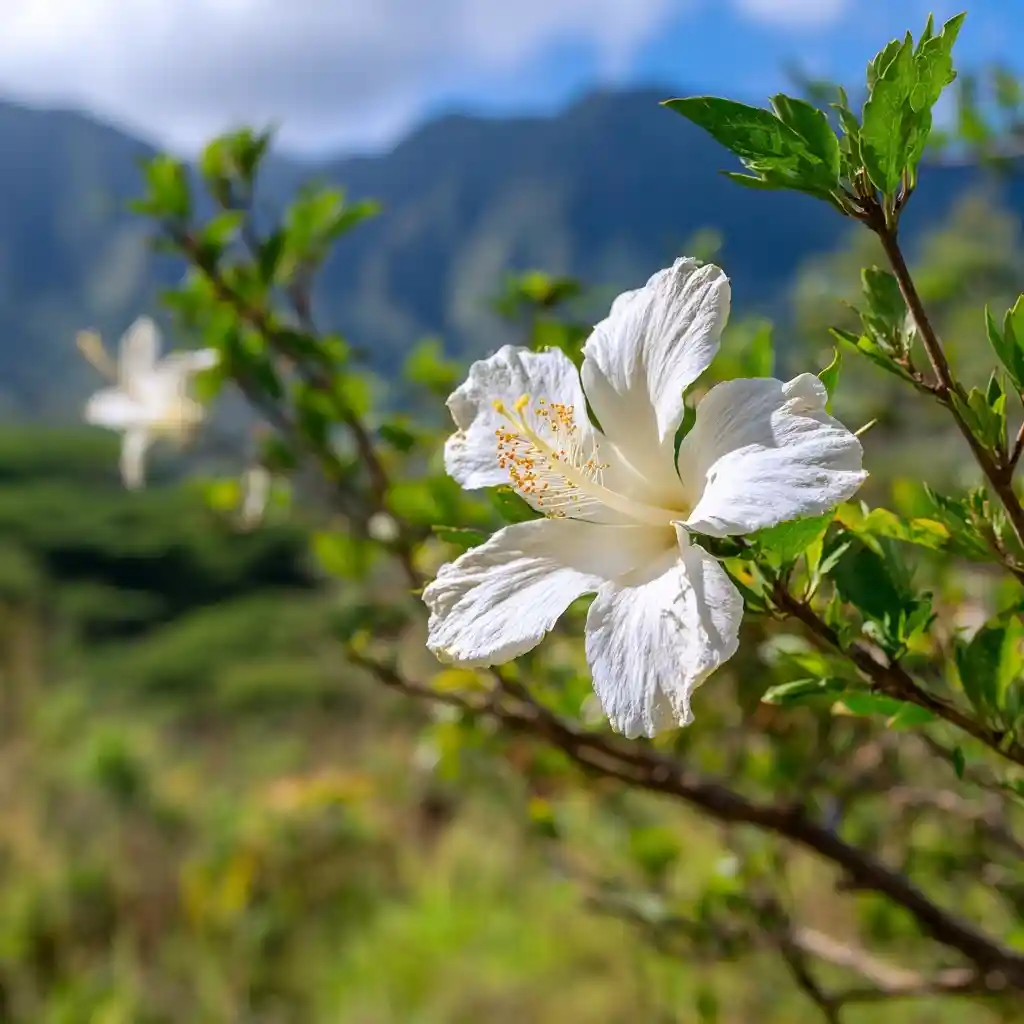
Native only to the islands of Oʻahu and Molokaʻi, the Hawaiian white hibiscus is a rare species that offers more than just visual beauty—it’s one of the few hibiscus flower types with a noticeable fragrance. The blooms are pure white with long pink stamens and open wide to reveal a crisp, elegant form.
Because it’s endemic to Hawaii, it thrives in tropical and subtropical climates and prefers full sun, high humidity, and moist, well-drained soil. It’s a stunning specimen tree or large shrub for warm regions.
- Height: 7–10 feet
- USDA Zones: 9–11
- Flower Color: White
- Best for: Tropical landscapes, fragrant gardens, collectors
🌺 29. Woody Rose-Mallow
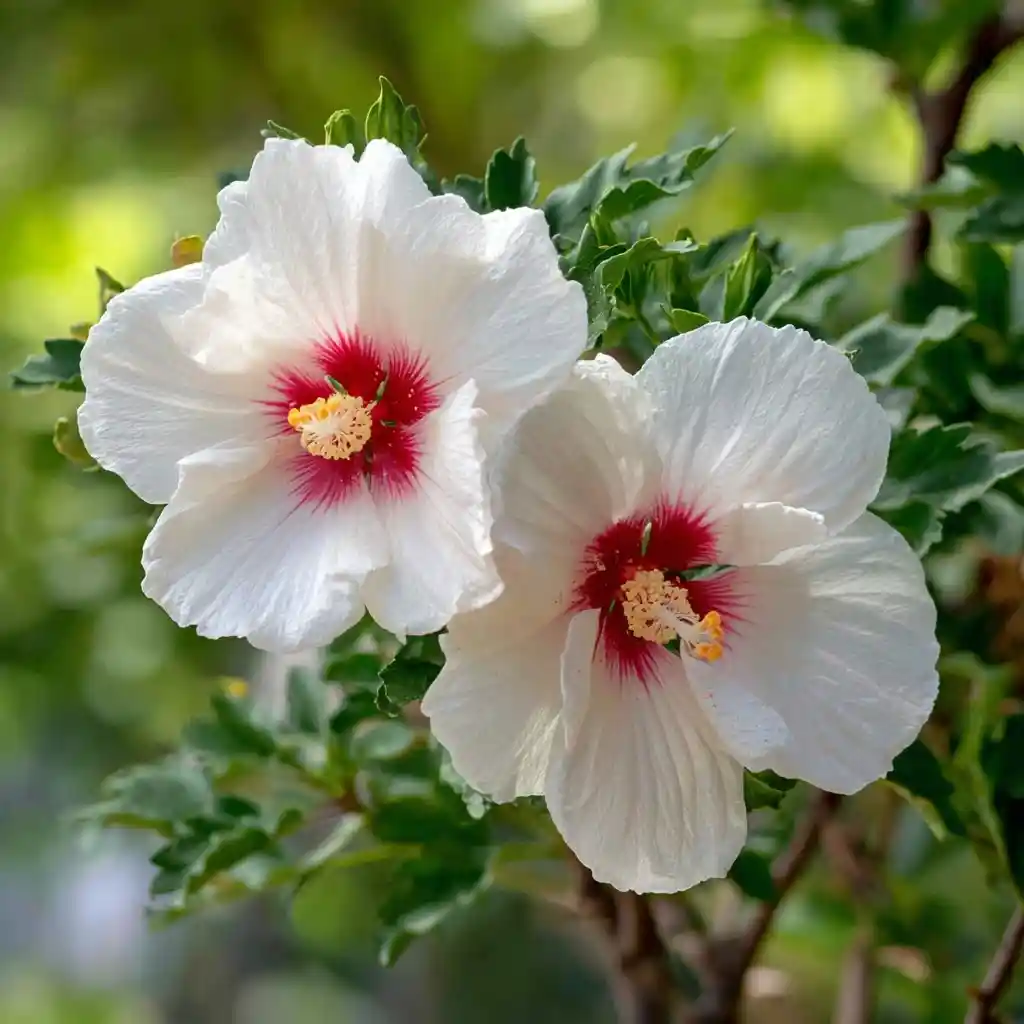
Also known as woolly rose-mallow, this hardy North American species produces large white or pale pink flowers with dramatic red centers. The foliage is fuzzy or “woolly,” giving the plant a unique texture, and its long bloom period stretches from late spring to early fall.
It adapts well to hot, humid climates and thrives in moist soil. Use it in wet meadows, streamside plantings, or anywhere you want long-lasting blooms and low maintenance.
- Height: Up to 8 feet
- USDA Zones: 5–9
- Flower Color: White or pale pink with red center
- Best for: Humid areas, native gardens, wildlife habitats
🌺 30. Sleepy Hibiscus

The sleepy hibiscus is a long-lived perennial featuring deeply cupped blooms in shades of pink and purple. It’s native to the southeastern United States and parts of the Caribbean, where it’s often found in moist woodlands and along marshy edges.
This variety blooms most prolifically in full sun and benefits from consistent watering, especially during hot weather. The soft-colored flowers and upright growth habit make it a good candidate for naturalistic plantings or low-maintenance beds.
- Height: 6–8 feet
- USDA Zones: 5–9
- Flower Color: Pink and purple with red centers
- Best for: Moist areas, native landscapes, perennial beds
🌺 31. Rock Hibiscus

Native to the arid landscapes of the American Southwest and northern Mexico, the rock hibiscus is a compact, drought-tolerant species perfectly suited for dry, rocky soils. Unlike most types of hibiscus flowers, this one thrives in desert conditions and requires minimal water once established.
The small, pale pink or lavender flowers appear throughout the year, especially after rain. Its sparse foliage and small stature make it ideal for xeriscaping, rock gardens, or containers in hot climates.
- Height: 1–3 feet
- USDA Zones: 7a and up
- Flower Color: Pink, lavender
- Best for: Desert gardens, rock gardens, low-water landscapes
🌺 32. Double Hibiscus

The double hibiscus refers to tropical cultivars bred for their lush, full blooms made of multiple ruffled petals. These flowers resemble peonies in form and are available in a dazzling array of colors—from red and pink to yellow and orange.
Perfect for creating a tropical ambiance, double hibiscus plants work well in borders, containers, or as focal points. Regular pruning encourages denser growth and more prolific flowering.
- Height: 6–10 feet
- USDA Zones: 9–11
- Flower Color: Multiple (red, pink, yellow, orange, white)
- Best for: Tropical themes, containers, lush flower beds
🌺 33. Hibiscus ‘Black Dragon’
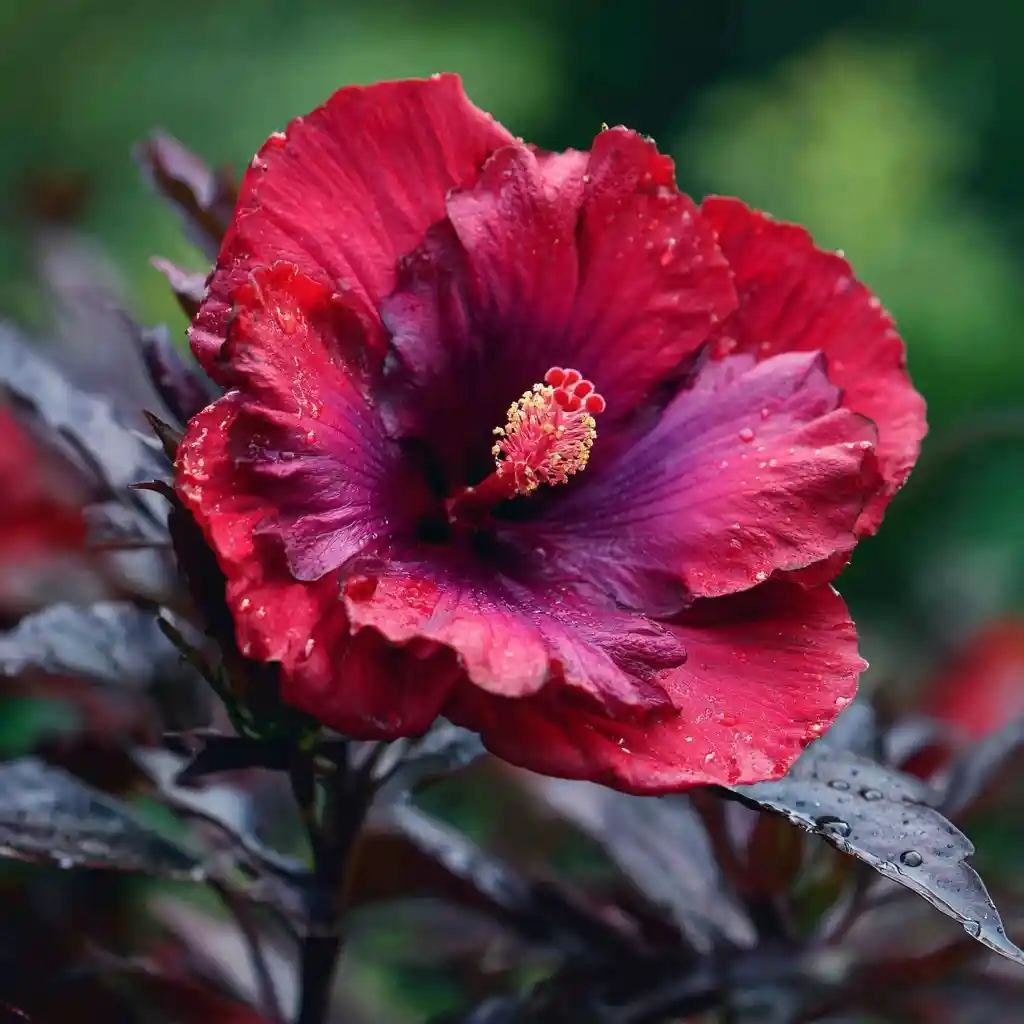
A standout among tropical cultivars, ‘Black Dragon‘ features massive, ruffled, deep crimson blooms with rare, dark purple centers—almost black in appearance. This award-winning hybrid makes a dramatic impact whether grown in-ground or in large containers.
Though slow-growing, it eventually fills out into a full shrub. Like most tropical hibiscus varieties, it thrives in full sun and requires well-drained soil and frequent watering.
- Height: 3–6 feet
- USDA Zones: 9–11
- Flower Color: Crimson with purple-black center
- Best for: Tropical collectors, dramatic borders, statement pots
🌺 34. Hibiscus ‘Fiesta Del Sol’
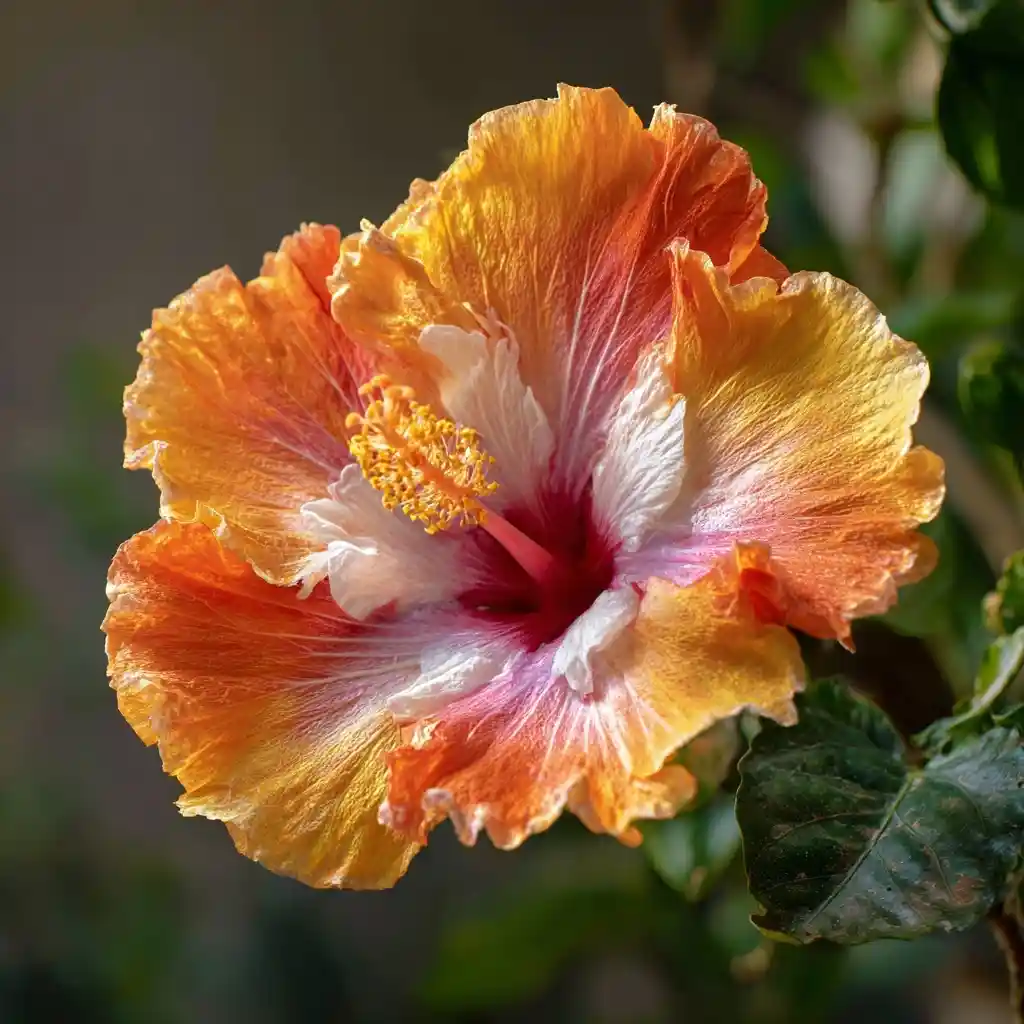
Just like its name implies, ‘Fiesta Del Sol‘ brings a burst of festive color to the garden. This tropical hibiscus variety opens each morning in vibrant orange hues, fading to yellow by evening—creating a day-long color transition. Its large blooms are further accented by deep burgundy centers with pink and white rings.
This cultivar thrives in full sun and moist, well-drained soil. It’s a must-have for those looking to make a tropical statement in containers or sunny garden beds.
- Height: 2–4 feet
- USDA Zones: 10–11
- Flower Color: Orange fading to yellow, burgundy center
- Best for: Colorful container gardens, small tropical beds, patios
🌺 35. Hibiscus ‘Midnight Tryst’

A kaleidoscope of color, ‘Midnight Tryst‘ offers multicolored blooms with dusky purple-gray starbursts, white veining, and bold pink petal edges. The center features a striking red eye, all adding up to an exotic, high-impact flower.
Although each bloom lasts just one to two days, the plant produces flowers continuously during the warm season. Provide rich, well-drained soil and frequent watering for best results.
- Height: 2–4 feet
- USDA Zones: 10–11
- Flower Color: Purple, gray, pink, white, red
- Best for: Statement containers, exotic flower lovers, warm-climate gardens
🌺 36. Hibiscus ‘The Path’
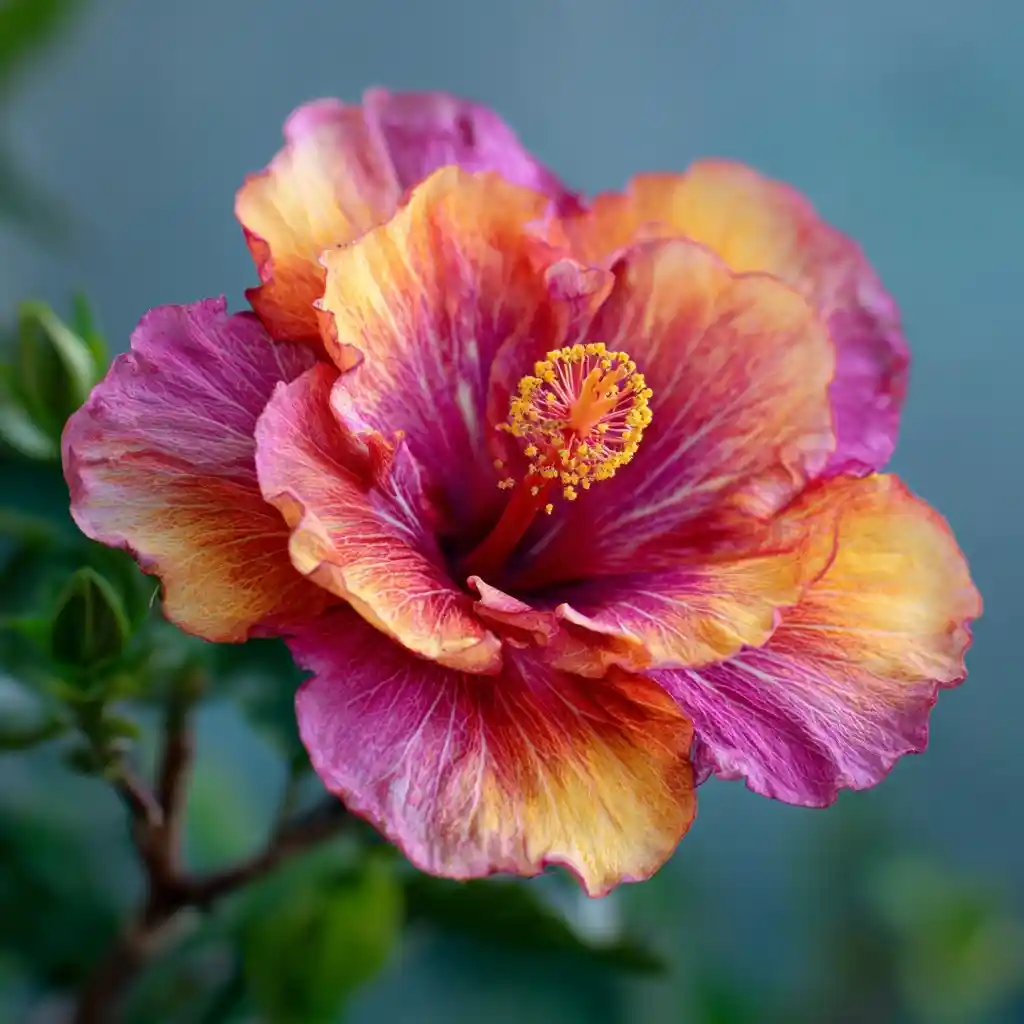
With dramatic ombré flowers that shift from yellow and orange on the edges to bright pink at the center, ‘The Path‘ is a tropical hibiscus cultivar that feels painted by hand. Its bold color gradient and prominent yellow stamens draw attention even from a distance.
This compact grower is excellent for large pots or border edges. Like all tropical types of hibiscus flowers, it needs full sun, regular watering, and well-drained soil to bloom consistently.
- Height: 2–4 feet
- USDA Zones: 10 and above
- Flower Color: Yellow, orange, pink gradient
- Best for: Color-focused gardens, sunny patios, tropical accents
🌺 37. Hibiscus ‘Voodoo Queen’
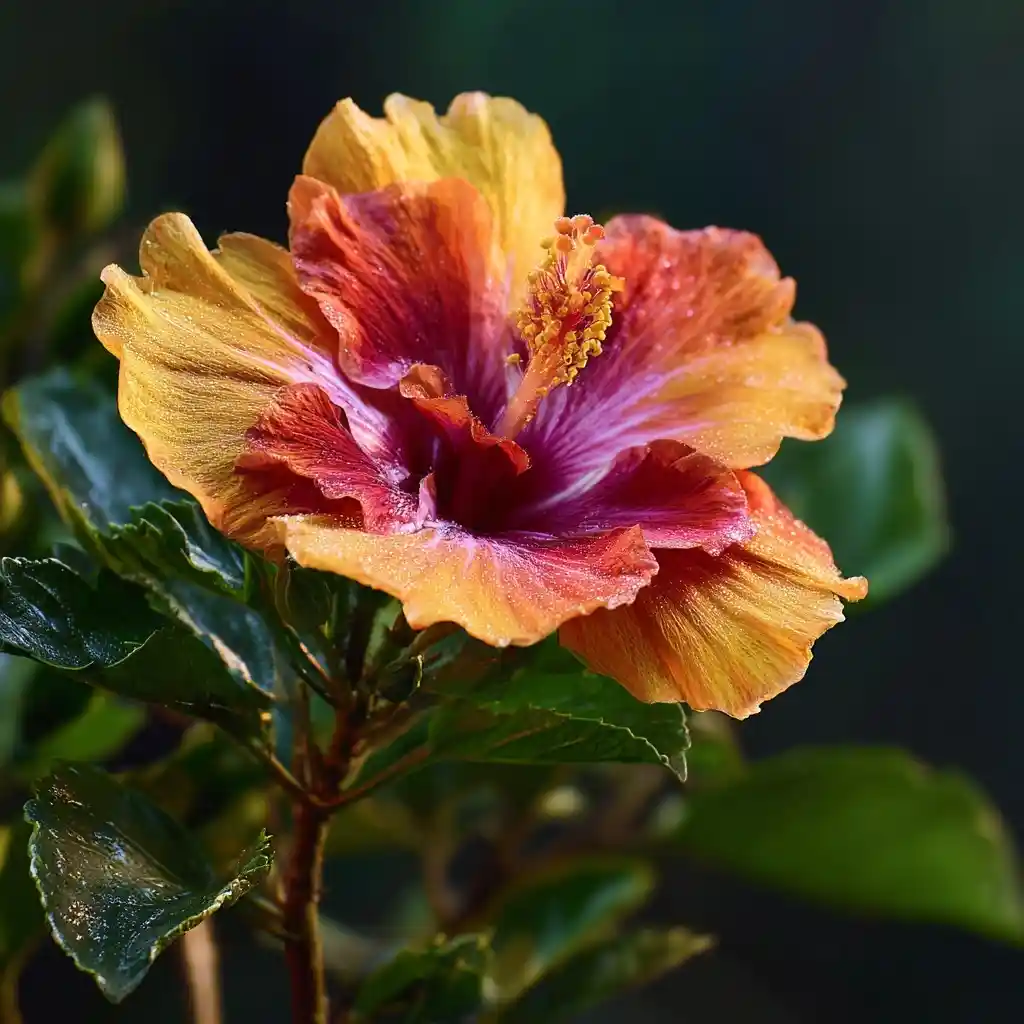
A shape-shifter in the garden, ‘Voodoo Queen‘ starts the day with dramatic reddish-orange flowers featuring a purple center and red throat. By afternoon, those same blooms transform into bright yellow with soft lavender-gray highlights, giving you a two-tone floral display from a single flower.
The seven-inch blooms are backed by glossy, dark green foliage, making this a standout in tropical borders or containers. Provide full sun and regular watering, especially during the heat of summer.
- Height: 2–4 feet
- USDA Zones: 9–11
- Flower Color: Red to yellow with purple and lavender centers
- Best for: Dynamic color shifts, sunny patios, exotic borders
🌺 38. Hibiscus ‘Christmas Angel’
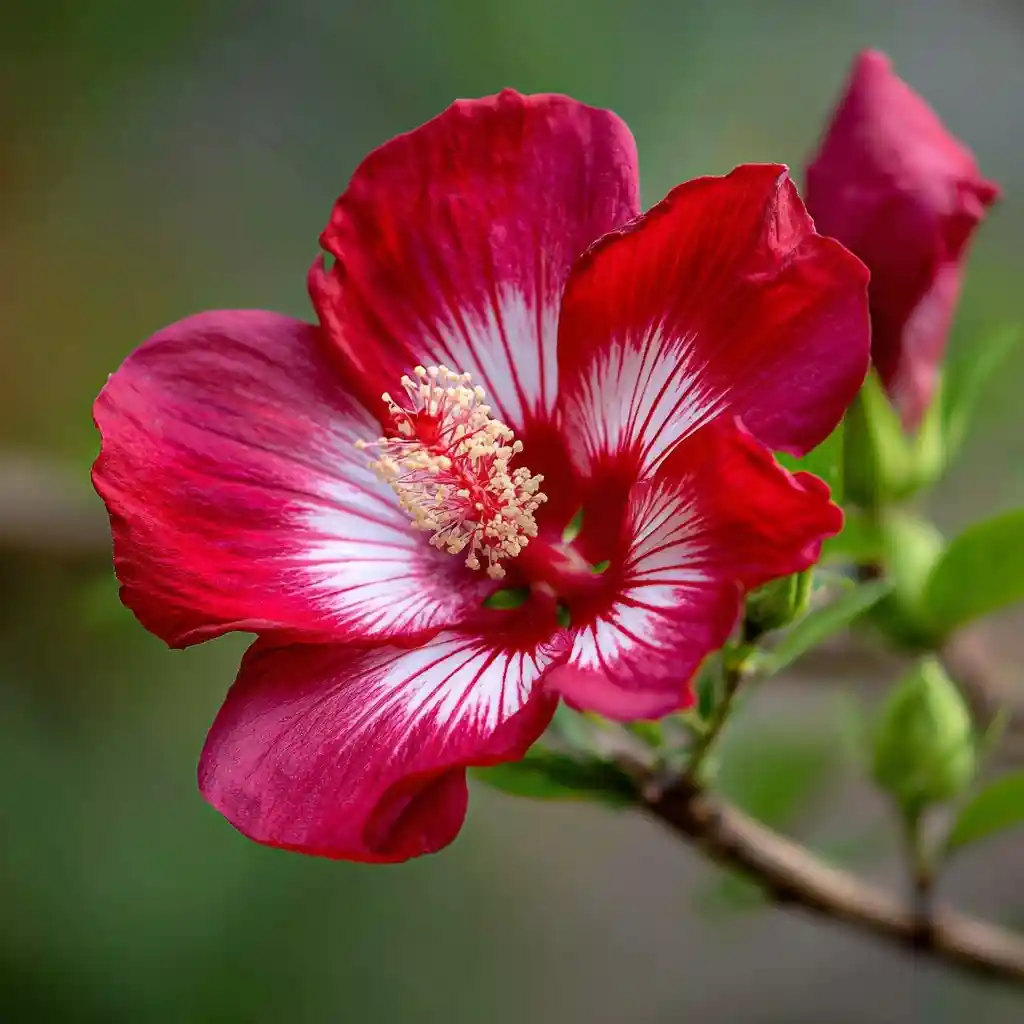
With its bold reverse color scheme, ‘Christmas Angel‘ delivers a festive twist. Its vibrant red petals are contrasted by a glowing white center and white veining—creating a striking contrast that’s both cheerful and elegant.
This hybrid hibiscus thrives in containers or garden beds with full sun and consistent moisture. It makes an excellent gift plant or seasonal feature near holiday blooms like poinsettias.
- Height: 2–4 feet
- USDA Zones: 9–11
- Flower Color: Red with white center
- Best for: Holiday-themed gardens, gift containers, tropical beds
🌺 39. Hibiscus ‘Variegated Pink’

What sets ‘Variegated Pink‘ apart is its gorgeous gray-green foliage with creamy white edges—providing multi-season interest even when not in bloom. The ruffled pink flowers pop dramatically against the pale, patterned leaves.
It stays compact and thrives in containers, making it a favorite for patios and small gardens. Grow it in full sun to maintain strong variegation and maximize flowering.
- Height: 2–3 feet
- USDA Zones: 9–11
- Flower Color: Pink
- Best for: Foliage color contrast, container displays, small gardens
🌺 40. Hibiscus ‘White Hot’
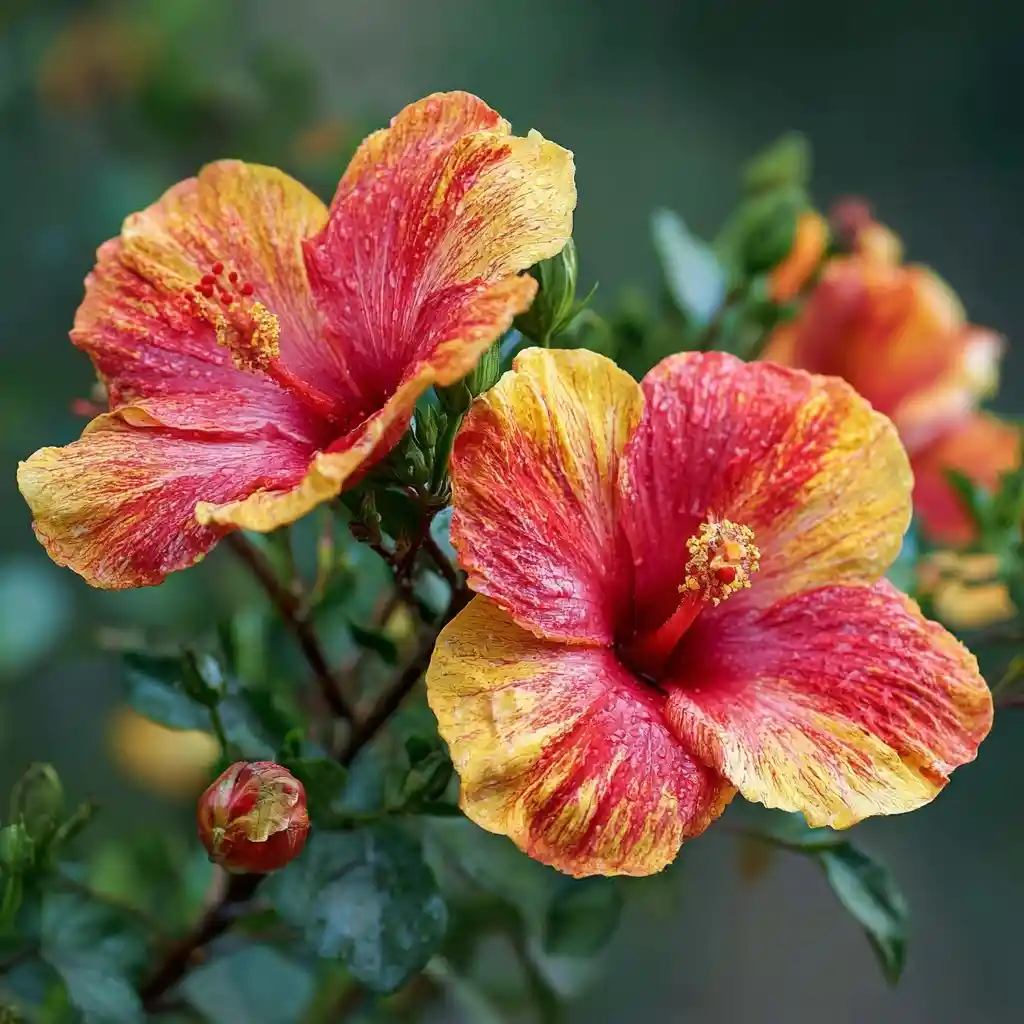
A true chameleon, ‘White Hot‘ is a tropical hibiscus that changes its flower color with the seasons. In cooler months, its blooms appear red with yellow speckles and a white center. As temperatures rise, the flowers transition to a bright yellow with fiery orange accents.
This cultivar’s upright, bushy form and dynamic color palette make it a brilliant choice for sunny garden beds or large patio containers. It thrives with regular watering and full sun.
- Height: 2–4 feet
- USDA Zones: 9–11
- Flower Color: Seasonal: Red/yellow/orange
- Best for: Color-changing interest, warm-season patios, seasonal beds
🌺 41. Hibiscus ‘Queen of Dreams’
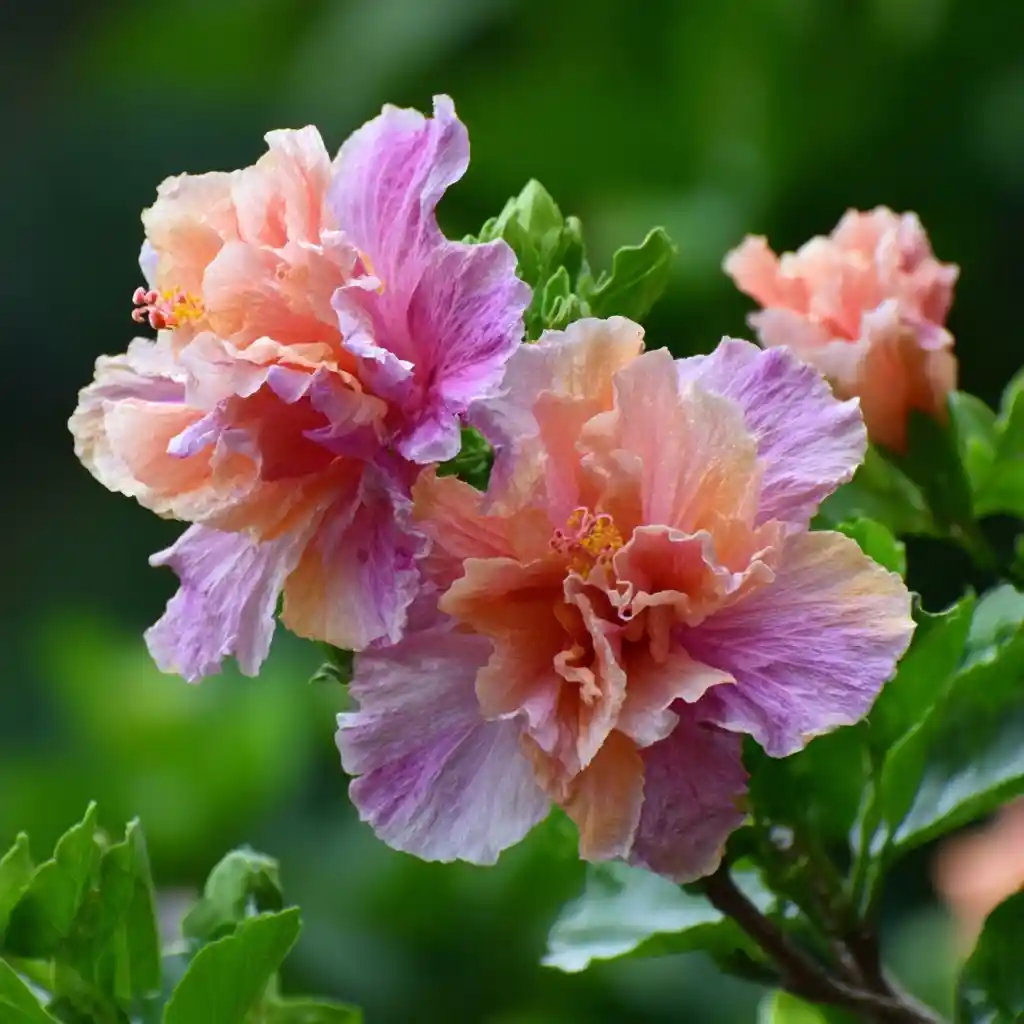
Regal in name and nature, ‘Queen of Dreams‘ produces double, frilly blooms that blend pastel peach, soft pink, and lavender tones. These large, multilayered flowers look hand-painted and shift color subtly as they age.
Ideal for containers or small spaces, this variety needs full sun and regular feeding to perform at its best. Its unique flower form and gentle hues make it a favorite among collectors and tropical plant enthusiasts.
- Height: 2–4 feet
- USDA Zones: 9–11
- Flower Color: Peach, pink, lavender
- Best for: Showy containers, collectors, pastel-themed gardens
🌺 42. Hibiscus ‘Kona’

The lush, ruffled petals of ‘Kona‘ come in varying shades of light and dark pink, offering an ever-changing look through the growing season. Its flowers appear in flushes, providing abundant color over a long bloom period.
Compact and container-friendly, this cultivar thrives in full sun and moist, well-drained soil. It’s well-suited for front porches, patios, and garden beds needing a pop of tropical charm.
- Height: 2–4 feet
- USDA Zones: 9–11
- Flower Color: Light and dark pink
- Best for: Tropical container gardens, balconies, warm borders
🌺 43. Hibiscus ‘Flameball’
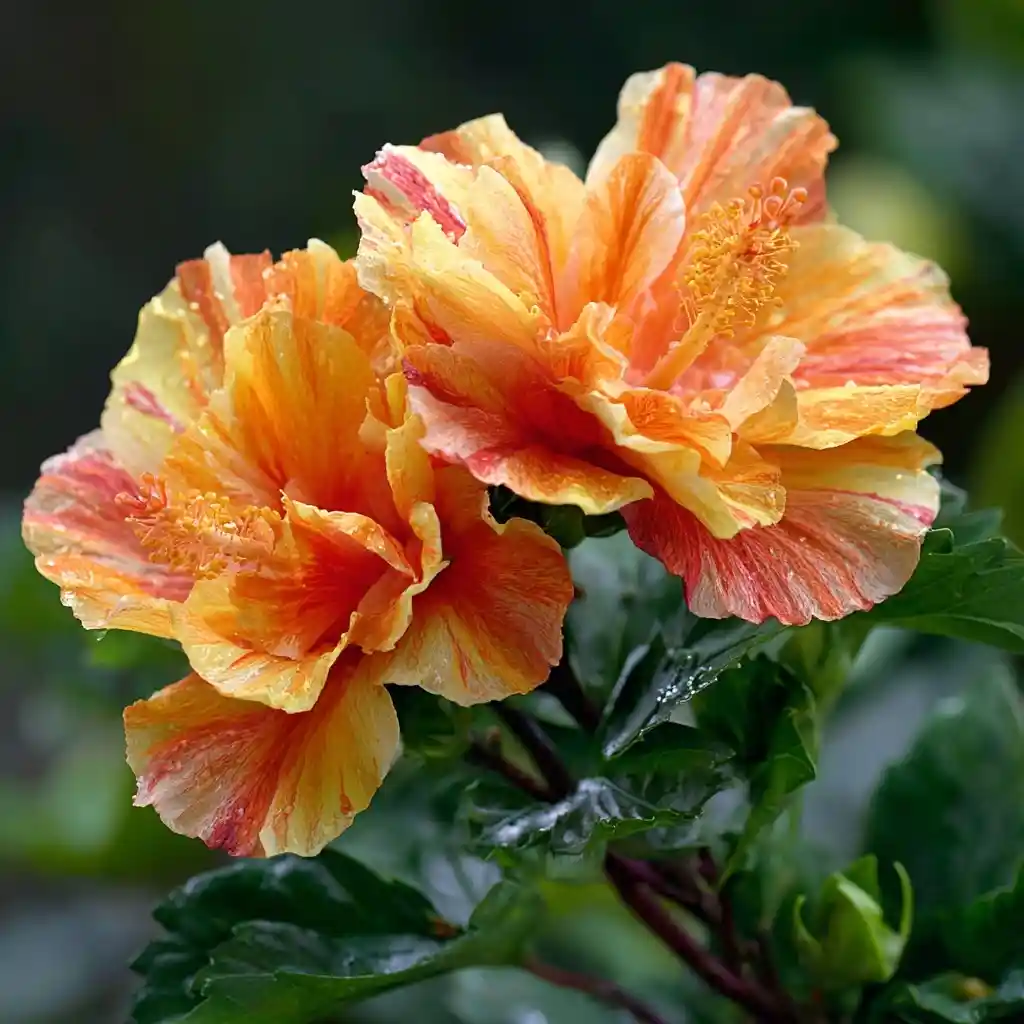
‘Flameball‘ is all about bold drama. It produces large, fluffy orange blooms with vivid yellow edges that resemble flames—hence the name. Each bloom spans up to five inches and appears consistently throughout the summer.
This tropical variety prefers heat, humidity, and plenty of sunshine. Prune lightly in fall to maintain shape and encourage bushier growth. Its intense coloration makes it a standout in vibrant garden schemes.
- Height: 2–4 feet
- USDA Zones: 9–11
- Flower Color: Orange with yellow edges
- Best for: Bold garden palettes, tropical accents, sun-drenched patios
🌺 44. Hardy Hibiscus ‘Midnight Marvel’
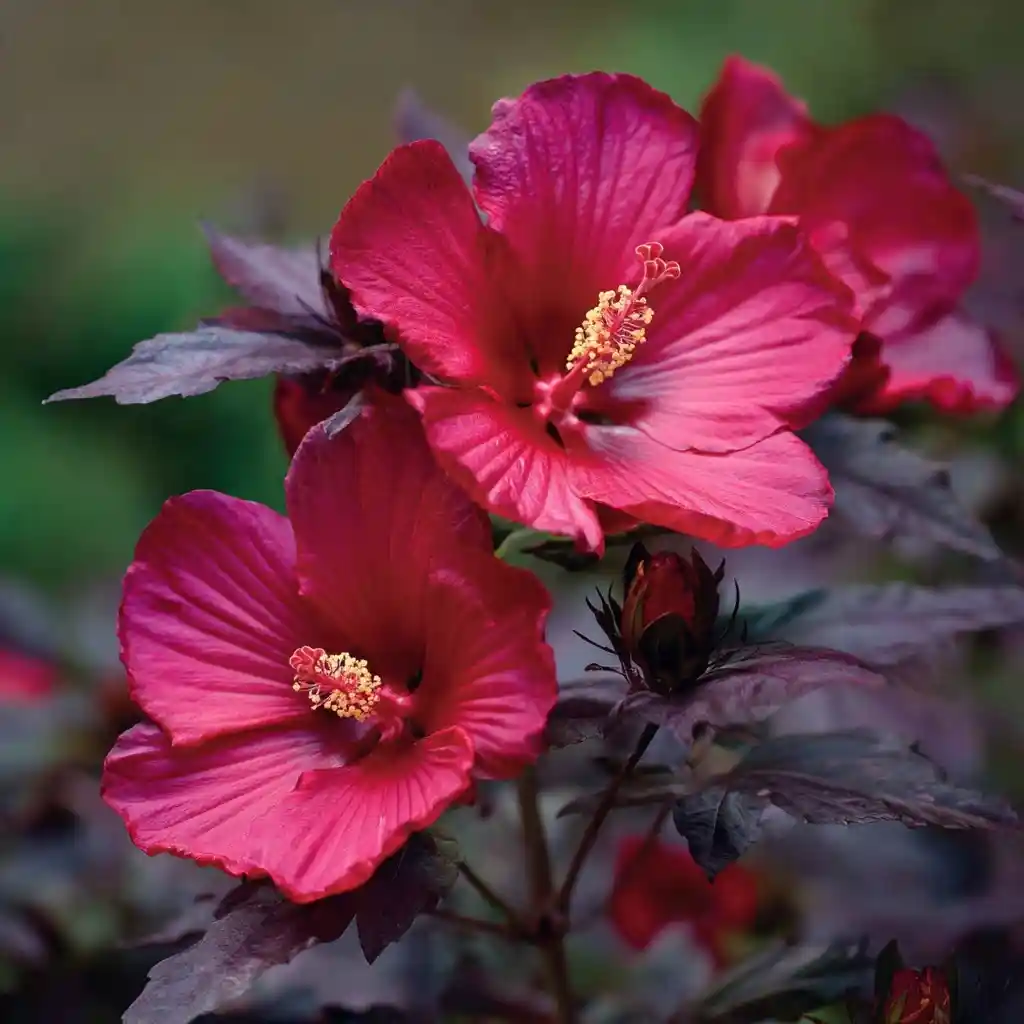
A hybrid favorite for northern climates, ‘Midnight Marvel‘ pairs enormous deep red flowers with dramatic purple-black foliage. The nine-inch blooms glow against the dark leaves, creating a rich, moody effect in borders or beds.
It’s cold-hardy, dies back in winter, and returns each spring stronger and bushier. This variety loves moisture and sun and works beautifully in rain gardens or near ponds.
- Height: 4–5 feet
- USDA Zones: 4–9
- Flower Color: Deep red
- Best for: Cooler climates, dramatic focal points, bold garden beds
🌿 Conclusion
With so many types of hibiscus flowers to choose from, there’s truly a variety for every garden style, climate, and skill level. Whether you’re drawn to the tropical drama of double blooms, the subtle charm of native swamp varieties, or the fragrance of Hawaiian white hibiscus, these plants offer more than just beauty—they invite pollinators, create structure, and provide months of vibrant color.
By choosing the right hibiscus for your region and garden goals, you can enjoy a lush, flower-filled landscape year after year. Just remember: most hibiscus varieties love sunlight, rich soil, and consistent moisture. In return, they’ll reward you with stunning blossoms and a garden that feels like paradise.
🌿 Love gardening inspiration? Follow me on Pinterest for bold plant ideas, tips, and seasonal color!
More Posts
